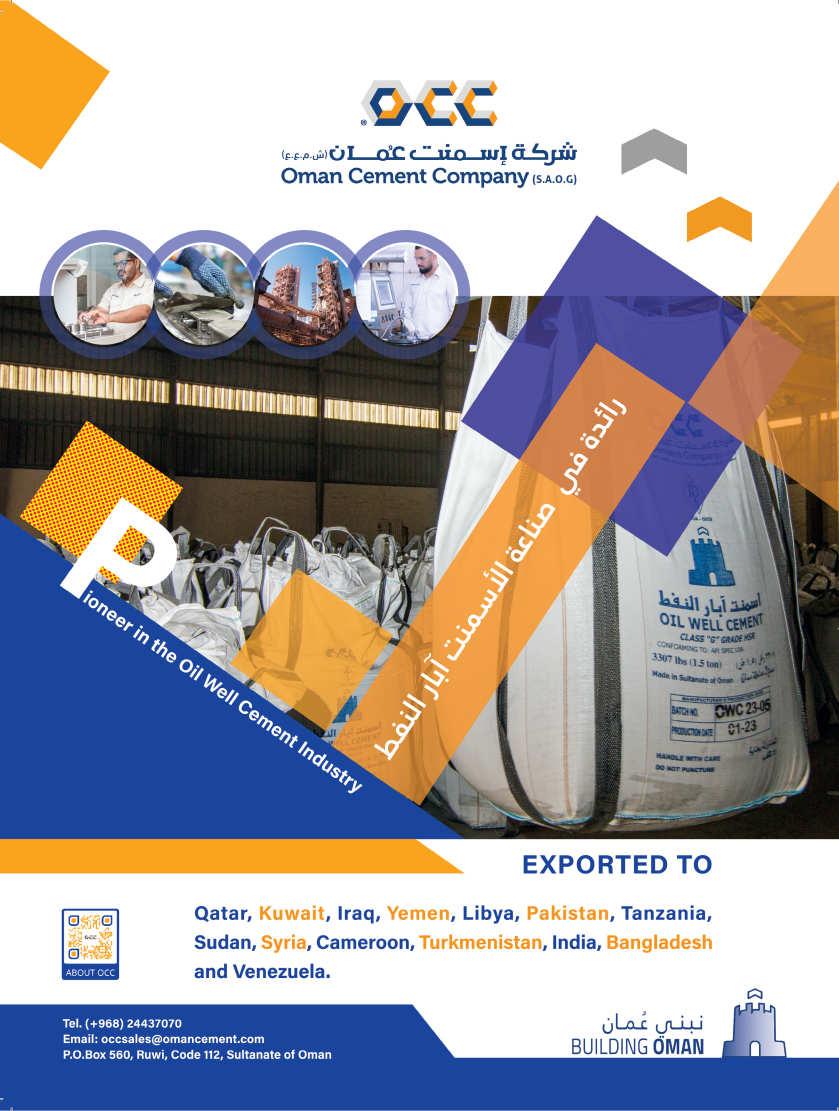EAST AFRICA:

hydrocarbon hotspot?
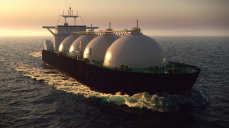

Geophysical data management
Diesel genset market is thriving Fabrication, flaring, offshore logistics
WWW.OILREVIEWAFRICA.COM VOLUME 18 | ISSUE 2 2023
Next
Advanced FLNG solutions are pushing Mozambique’s position as a global LNG producer and exporter, PG 14

Things are looking up for East Africa’s oil and gas sector.
(Image Credit: Adobe Stock)
EDITOR’S NOTE
IN THIS ISSUE, we are zooming in on East Africa’s upstream industry, which is progressing by leaps and bounds. An array of discoveries in countries such as Kenya, Tanzania and Uganda have drawn in investments from Shell and TotalEnergies to ExxonMobil.
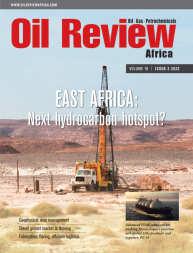
Mozambique, on the other hand, is making it big on the LNG front as it targets the ripe markets of Asia and Europe, while also reserving enough for domestic use.
Africa is witnessing unbelievable technological breakthroughs that can weather the toughest exploration spots. Robotics are becoming more and more common in the industry as it can overcome any inaccessible zones that make up the complicated oil and gas infrastructure. Turn the pages to check out all these and much more!
Madhurima Sengupta Editor
CONTENTS
Editor: Madhurima Sengupta
madhurima.sengupta@alaincharles.com
Editorial and Design team: Prashanth AP, Fyna Ashwath, Miriam Brtkova, Praveen CP, Robert Daniels, Shivani Dhruv, Matthew Hayhoe, Leah Kelly, Rahul Puthenveedu, Madhuri Ramesh, Louise Waters and Minhaj Zia
Publisher: Nick Fordham
Head of Sales: Vinay Nair
E-mail: vinay.nair@alaincharles.com
International Representatives
IndiaTanmay Mishra
NigeriaBola Olowo
USAMichael Tomashefsky
South AfricaSally Young
Head Office:
Alain Charles Publishing Ltd University House, 11-13 Lower Grosvenor Place, London SW1W 0EX, United Kingdom
Tel: +44 (0) 20 7834 7676 Fax: +44 (0) 20 7973 0076
Middle East Regional Office:
Alain Charles Middle East FZ-LLC Office L2-112, Loft Office 2, Entrance B
P.O. Box 502207, Dubai Media City, UAE
Tel: +971 4 448 9260 Fax: +971 4 448 9261
Production: Rinta Denil, Ranjith Ekambaram, Eugenia Nelly Mendes and Infant Prakash
E-mail: production@alaincharles.com
Subscriptions: circulation@alaincharles.com
Chairman: Derek Fordham
Printed by: Gemini Print Group
Printed in: April
© Oil Review Africa ISSN: 0-9552126-1-8
Borouge expansion, NIEC 2023, Algeria and OPEC+ countries cut production, NILEPET-ADNOC energy transition collaboration
16
Offshore logistics
West Africa’s logistics and infrastructure have grown steadily alongside its offshore industry TECHNOLOGY AND OPERATIONS
17
East Africa
Drones
Best approach to leak detections


20
Digital Twins
Innovative collaborations spell the next digital transformation
INTERVIEW
32
Serving the world of business
A new dawn for Zambia Zesco’s strategic plans on revitalising the country’s energy sector
NEWS 4 Calendar of events Diary dates of executives 6 News
COVER STORY 12
SPECIAL FEATURES 14
has seen many
discoveries by major
The region is cating up fast with West Africa
Mozambique The country
gas
oil giants
ISSUE 2 2023 • WWW.OI LREVIEWAFRICA.COM 3
Executives Calendar 2023
MAY
1-4 Offshore Technology Conference
Houston
https://2023.otcnet.org/
16-18 Africa Energies Summit
London
https://www.africaenergiessummit.com/
18-20 Oil & Gas International Trade Exhibition
Nairobi
https://www.expogr.com/kenyaoil/
JULY
2-6 NOG Energy Week
Abuja
https://www.nogenergyweek.com/
AUGUST
31-2 SPE Nigeria / NAICE
Lagos
https://www.naice.spenigeriacouncil.org/
SEPTEMBER
5 - 8 Gastech
Milan
https://www.gastechevent.com/
5 - 8 SPE Offshore Europe
Aberdeen
https://www.offshore-europe.co.uk/
6 - 7 Mozambique Gas and Power
Maputo
https://www.mozambiqueenergysummit.com/
Offshore Technology Conference 2023 to explore visionary ideas
THE OFFSHORE TECHNOLOGY Conference
2023 is all set to greet participants and visitors in Houston, Texas, the US, from 1 to 4 May. Supporters this year include Aramco, Nabors, Petrobras, Maersk and ExxonMobil to name a few.

As the name suggests, OTC unites professionals from across the globe to explore scientific and technological breakthroughs in the offshore industry. This year will mark the conference’s 50th run. Over the years, the event has expanded beyond Houston, with OTC Brasil and OTC Asia.
Visitors can look forward to a wholesome technical programme that covers everything from insightful panel sessions, technical / poster sessions, the keynote speaker series, networking events and exhibitions, to the New Technology Awards Ceremony, energy transition presentations
and executive dialogues. There will be discussions regarding carbon capture and storage. Various aspects of it, such as the best approach for storage, from subsurface quality to surface infrastructure and commerciality will be discussed at the session.
A panel on energy transition outlook will delve into the vast concepts of sustainability, investments, and the challenges
and opportunities involved in realising the potential of clean energy.
Representatives from Shell, Wood Mackenzie, bp, Baker Huges and Petrobras, among others, will be participating in a panel discussion on deepwater’s role in the energy transition journey. Oil and gas companies are having to balance producing fossil fuels while maintaining the carbon footprint, as it is difficult
to altogether shun fuels, given the volatile atmosphere from the ongoing Russia-Ukraine war and global inflation. That’s why deepwater oil and gas and offshore technologies still remains relevant.
Another panel on balancing energy transition and production will look into trending strategies and technologies that can help achieve balance of net neutral hydrocarbon production. The concept of eco-environmental investment, besides liquefied natural gas (LNG), hydrogen and alternate fuels, will also be touched upon.
The four-day event will also include a sprawling exhibition with participants such as Teledyne Marine, TGS and Subsea7, as well as a South Africa Pavilion, highlighting companies operating in fabrication, repair and maintenance, specialised engineering and other services to the upstream industry.
ISSUE 2 2023 • WWW.OI LREVIEWAFRICA.COM EVENTS CALENDAR 4
Readers should verify dates and location with sponsoring organisations, as this information is sometimes subject to change.
Image
Credit: Adobe Stock
OTC 2023 is returning to Houston from 1 to 4 May.
FIELD-PROVEN SEISMIC TEC HNOLOGY FOR TOUGH LOCATIONS
RAPID TECHNOLOGY ADVANCES have reshaped the seismic industry in recent years, a trend that is set to continue, according to industry experts. The demand for seismic continues to thrive within Africa’s oil and gas industry.
Announcing its Q4 2022 results recently, CGG reported that its technology leadership, as well as a high backlog of work, will sustain business growth throughout 2023 and beyond. It operates across three core markets: geoscience, earth data, and sensing and monitoring.
In the latter, CGG highlighted activity in the North African market, plus sales of its WiNG technology also gaining momentum. A wireless and compact nodal acquisition solution, WiNG is designed for difficult-toaccess environments and has proved its worth in varied environments.
With its field-proven Pathfinder transmission management technology, operators can view an entire acquisition spread in real time to ensure comprehensive and efficient quality control. Unlike systems based on blind nodes, WiNG with Pathfinder technology provides peace of mind for operations and can also significantly reduce personnel and field verification time. Its success also shows how much technology now underpins this entire segment, an area that has long supported upstream exploration across Africa and elsewhere.
In North Africa, Sercel, CGG’s sensing and monitoring division, is deploying an 80,000channel 508XT acquisition system and 24 Nomad 65 Neo broadband vibrators on a 3D mega-crew seismic survey onshore in late 2023.
The Nomad 65 Neo all-terrain vibrator, selected for its ability to operate efficiently in harsh conditions, will be used with Sercel’s Smart LF software to reduce vibrator-induced

low-frequency distortion and record a highquality dataset over the widest frequency range. This equipment will join an existing installed base of two 508XT systems, representing a total 180,000 channels, and a fleet of 30 Nomad 90 Neo vibrators that were delivered in 2021 to equip two other major projects in the same area.
There are signs of robust demand in West Africa too, the continent’s main oil-producing region. TGS, the Norwegian energy data and intelligence provider, announced in March that it had secured pre-funding for a new
multi-client 3D seismic survey in the West Africa area to commence during Q2 2023. It will be the first 3D project to be performed under a recently announced multi-year vessel agreement with drilling contractor, COSL. The survey will be acquired by COSL’s state-of-the-art Hai Yang Shi You 721 (HYSY721) vessel, with final processed delivery to be completed by Q3 in 2024. TGS said the project will expand its 3D seismic data coverage, providing high-quality data in a ‘key emerging basin’ in one of West Africa’s prolific hydrocarbon provinces.
“It will be processed using Pre-stack Time (PSTM) and Pre-Stack Depth (PSDM) workflow with Full Waveform Inversion (FWI), enabling improved imaging of the subsurface for acreage evaluation, supporting license rounds within the region and providing excellent growth opportunities for energy companies,” the company noted in a 6 March statement.
Data provider CGG will sustain business growth throughout 2023 and beyond.”
State-of-the-art seismic technology, that has been proven in the field, brings reassurance to drillers in some of Africa’s toughest exploration hotspots, says Martin Clark.
SEISMIC TECHNOLOGY ISSUE 2 2023 • WWW.OI LREVIEWAFRICA.COM 5
Demand for seismic continues to thrive within Africa’s oil and gas industry.
Image Credit: Adobe Stock
Borouge signs agreement for further East Africa expansion
LEADING PETROCHEMICAL
COMPANY, Borouge Plc, which specialises in innovative and differentiated polyolefin solutions, has entered into a Distribution Agreement with Somochem; one of the biggest polyolefin distributors in East Africa.
The agreement builds on an already established relationship between the companies and aims to increase Borouge’s footprint and presence in East Africa.
Over the past five years, Borouge has grown in its East African sales of infrastructure solutions and doubled its sale volume of advanced packaging solutions.
Khalfan Al Muhairi, senior vice president, Region MEAE, Borouge, said, “We are sharpening our focus on the growing demand in East Africa,
now a major strategic market for Borouge. We identified a gap in the region for multiple premium solutions, enabling us to unlock opportunities to grow our market share over the next five years.
“In 2022, we increased our sales of advanced packaging solutions in East Africa to reach
Kinetiko receives IDC funding for JV development
KINETIKO ENERGY HAS released an update on its current gas exploration and production development projects, including the joint venture with the Industrial Development Corporation of South Africa (IDC).
AED496mn (US$135mn), and sales of energy and infrastructure solutions to AED184mn (US$50mn), demonstrating our position as a reliable and trusted partner to the region’s biggest brands and distributors. We are bullish on the future growth in East Africa.”

Ghana set to double crude oil production
ACCORDING TO THE African Energy Chamber, Ghana, one of Africa’s rapidly evolving oil and gas markets, is seeking to double its crude oil production by the end of 2023.

The numbers are set to
increase from approximately 180,000 bpd to 420,000 bpd, backed by commercial discoveries in the Tano Cape Three Points block.
“Ghana has positioned itself to attract investments in the
energy sector,” said Egbert Faibille Jr, CEO of Petroleum Commission of Ghana.
“We have several blocks open for direct negotiation and three available for farm-in opportunities. We have some fields that are in predevelopment, so if we are able to get contractors, we should see a surge in production by 2030.”
At least 26 drilling campaigns and rigs are expected in Africa this year, setting the stage for its upstream revival, according to the Chamber.
“Two-thirds of oil resources are exported out of Africa. As governments, we need to be able to come together and ensure that our resources are being used for African development,” commented OA Danquah, CEO of Ghana National Petroleum Corp.
The IDC, a wholly owned subsidiary of the South African government mandated to promote economic growth and industrial development, has advanced R16.3mn (US$877,000) as part of its R70mn (US$3.8mn) commitment into its joint venture with Afro Energy, the proposed 100% subsidiary of Kinetiko.
The project is for the development of commercial gas production in the Amersfoort region within exploration Right 12/2/271. The project will be undertaken in two phases; the development of approximately 10 wells and the construction of a gas terminal with a gas treatment and processing plant, metering station and pipeline gathering system; and the commencement of gas production from existing wells and the development of approximately 10 additional wells and expansion when necessary.
“The involvement of the IDC in our project at an asset level is a manifestation of the government’s confidence in the viability of our transition energy vision. Our current intention is to focus the joint venture we have created with the IDC on the development of producing fields in the southern part of Block ER271, for which we have begun the process of converting to a multi-decade Production Right,” said Nick de Blocq, Kinetiko CEO.
ISSUE 2 2023 • WWW.OI LREVIEWAFRICA.COM NEWS 6
Numbers are set to increase from around 180,000 bpd to 420,000 bpd. Image Credit: Borouge Plc Image
Credit: Adobe Stock
The signing ceremony between Borouge Plc and Somochem.
San Leon Energy provides update on Midwestern transactions
SAN LEON, THE independent oil and gas production, development and exploration company focused on Nigeria, has announced a further update in relation to the proposed transactions with Midwestern Oil & Gas Company and the Company's further conditional investments in ELI (together the 'Proposed Transactions'); its current refinancing discussions; and an Energy Link Infrastructure (Malta) Limited ('ELI') operational update.
Further to the announcement made on 24 March 2023, all of the longstop dates in relation to the Proposed Transactions have now been extended to 30 June 2023, in agreement with Midwestern and the other relevant parties.
As announced in March, the Board continues to believe that the Proposed Transactions will be transformational for the Company and it continues to work towards completing them. However, the Board notes the recent challenge by NNPC Limited and OML 18 Energy Resource Limited to the operatorship of Oil Mining License (OML) 18 and the potential delays this will cause to the Proposed Transactions. The extension of the longstop dates, inter alia, reflects this.
Also as announced by the Company, San Leon remains in discussions for the proposed refinancing. Those discussions are continuing to progress, and the Board expects to make significant headway with the proposed refinancing in the near term. Further announcements will be made as and when appropriate.
NIEC 2023 to mirror the booming Namibian energy sector
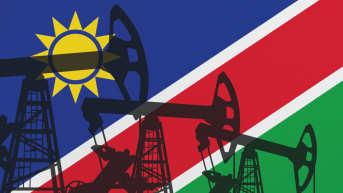
THREE MAJOR OIL and gas discoveries, billions of dollarsworth of green hydrogen projects launched, and a suite of multiindustry project developments represent some of the defining features of Namibia’s energy sector over the last year. With these achievements, newfound growth across the market has been triggered as players flock to the country in the hopes of mirroring the success already seen. Eager to maintain this growth momentum, the fifth edition of the Namibia International Energy Conference (NIEC) will once again unite policymakers, industry heads, global investors and energy experts for three days of dialogue, serving as the premier forum where new deals can be signed and best practices shared.
As global explorers turn their attention to the Namibian market, NIEC 2023 serves to advance the signing of deals and forging of partnerships by offering a platform for heightened engagement and dialogue among industry stakeholders. During the conference, dedicated upstream

panel discussions covering topics such as transforming resources into economic development; investing in Namibia’s energy sector; Namibia upstream O&G insight, and the journey towards value creation will offer an indepth insight into the evolving oil and gas landscape.
Mitigating perceived risk in African Energy Investment
A HIGHLEVEL PANEL comprising African public and private sector energy leaders discussed strategies for mitigating project development risk during the African Energy Chamber’s Invest in African Energy reception in Dubai on 30 March, 2023, which aimed to connect international financiers with African energy projects. Africa is widely recognised as an attractive investment destination due to its abundance of natural resources, an above-average drilling success rate, a rapidly expanding domestic market, growing purchasing power and associated needs for power, technology, innovation and industrialisation. However, the continent continues to experience a high degree of perceived risk.
Under the theme, “Africa’s Advantage: Countering the Myth of Africa-Specific Risk,” the panel comprised Egbert Faibille Jr., CEO of Ghana’s Petroleum Commission and Elison Karuhanga, Partner of Uganda’s Kampala Associated Advocates, and was moderated by Amena Bakr, chief OPEC correspondent and Dubai deputy bureau chief for energy intelligence.
With Covid-19, the price of crude oil became
volatile, and the risk to the energy transition reduced investor appetite, meaning heightened transparency has become critical to sustaining foreign direct investment flows and mitigating perceived risk.
Recent efforts by several African countries to join the Extractive Industries Transparency Initiative (EITI) – a global standard for the responsible governance of oil, gas and mineral resources – have demonstrated a continent-wide desire to improve transparency.
NEWS ISSUE 2 2023 • WWW.OI LREVIEWAFRICA.COM 7
Panelists at the African Energy Chamber’s Invest in African Energy event in Dubai.
Image Credit: Adobe Stock
Image Credit: African Energy Chamber
NIEC 2023 will explore the theme Shaping the Future of Energy Towards Value Creation.
Algeria and OPEC+ countries cut production
SOME OPEC+ COUNTIRIES
including Algeria have surprised markets with a voluntary cut of 1.15mn barrels per day (bpd) causing oil prices to rise and feeding inflationary fears.
The voluntary cut is a precautionary measure aimed at supporting oil market stability. If fully delivered, the announced cut would further tighten an already fundamentally tight oil market, driving the Brent benchmark towards US$100 per barrel sooner than previously expected and would push the price to around US$110 per barrel this summer.

The supply cuts are scheduled to start from May, which coincides with the refinery presummer season ramp up and an anticipated refined products demand rebound.
Before the new OPEC+ cuts were announced, Rystad Energy was anticipating the crude oil market to be in deficit to the tune of 1.4mn bpd between May and August. These voluntary reductions are in addition to the current official OPEC+ cuts of
2mn bpd announced back in October 2022 for the period November 2022 – December 2023.
Saudi Arabia will shoulder most of the cuts, reducing production by 500,000 bpd. Other participants are the UAE
ReconAfrica confirms new fold belt in Kavango basin
AS A RESULT of recent data from its ongoing phase two 2-D seismic programme, Reconnaissance Energy Africa (ReconAfrica) has announced a significant new play type has been confirmed in the southern and western parts of its around 6.3mn acre exploration licence area in Namibia – PEL 73.
(144,000 bpd), Kuwait (128,000 bpd), Iraq (211,000 bpd), Oman (40,000 bpd), Algeria (48,000 bpd) and Kazakhstan (78,000 bpd), according to statements from their respective governments.
QatarEnergy explores Mauritania opportunity
The new ‘Damara Fold Belt’ consists of a very prominent and clearly imaged series of anticlinal structures, also known as Whaleback anticlines. These elongated anticlinal folds, which are often faulted, have a consistent linear trend. With growing seismic data coverage used to identify these fold structures, 16 such structures have been recognised so far, with an areal extent of up to 50,000 acres and around 650 ft of column height.
QATARENERGY
HAS ENTERED into an agreement with Shell to acquire a 40% working interest in the C-10 block offshore Mauritania.
Subject to approvals by the Government of Mauritania, Shell (operator) will hold a 50% interest in the block while Société Mauritanienne des Hydrocarbures (SMH) will hold a 10% interest.
The C-10 block covers a total area of approximately 11,500 sq km and is located around 50 km off the coast of Mauritania in water depths of approximately 50 to 2,000 m.
QatarEnergy, commented, “We’re excited about the opportunity to participate in Mauritania’s upstream sector which further builds on our exploration footprint in Africa, and we look forward to a successful exploration programme.
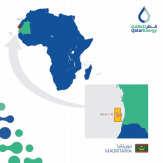
“We are delighted to have the opportunity to work with our strategic partner Shell and with SMH. We also look forward to collaborating with the Mauritanian Government and thank them and our partners for their valuable support and cooperation.”
Extension of the phase two seismic programme, which is currently being acquired, was designed to increase the seismic control, validate and delineate the full extension of this new play type. The 2D seismic data will be supplemented by a high resolution eFTG (Full Tensor Gravity) survey, recently permitted. An integrated interpretation of seismic, well data, eFTG and aero-magnetics has been prioritised and will enable three dimensional mapping of these large structures.
The company has applied for drilling permits for six Damara locations, which are subject to further refinement once final data acquisition and interpretation are completed by July 2023. Subject to permitting, it expects to drill the first Damara Fold Belt location shortly after.
ISSUE 2 2023 • WWW.OI LREVIEWAFRICA.COM NEWS 8
H.E. Saad Sherida Al-Kaabi, the Qatari Minister of State for Energy Affairs and the President & CEO of
The C-10 block covers a total area of approximately 11,500 sq km.
Image Credit: Adobe Stock
Image Credit: QatarEnergy
The supply cuts, mostly to be shouldered by Saudi Arabia, are scheduled to start from May.
Finance leaders advance deals at SSOP
SOUTH SUDAN OIL & Power (SSOP) returns to Juba for its sixth edition from 14-16 June with the aim of promoting the country as the engine of East African growth.
The country’s Minister of Finance and Economic Planning Dier Tong Ngor will open the conference together with the Minister of Petroleum, the Minister of Energy and Dams, the Minister of Mining and the Minister of Investment.
Consolidating the event’s position as the platform where energy deals are made, and following the Minister’s keynote, a finance panel will explore how to invest in the country, opportunities for regional expansion and strategies for capital raising.
Returning for another year, Ryan O’Grady, CEO of South Sudanese financial institution Kush Bank will discuss local rules and regulations, investment protection and multilateral partnerships.
Facilitating discussions on market access and financing solutions, Admassu Tadesse, group president Emeritus and managing director of the Trade & Development Bank will also join the finance panel. African financial institutions Afreximbank and Stanbic Bank will also feature on the panel.
“South Sudan’s position as the engine of East African growth will trigger newfound investments across the entire regional value chain. SSOP’s finance panel lays the foundation for deals to be signed,” stated James Chester, senior director at SSOP event organiser Energy Capital & Power.
NILEPET and ADNOC to promote inclusive energy transition
SOUTH SUDAN’S NATIONAL oil company NILEPET and the Abu Dhabi National Oil Company (ADNOC) met in Abu Dhabi, with capacity building and partnership at the top of the agenda.
NILEPET is in the UAE meeting with investors in Dubai and Abu Dhabi, and attending the Invest in African Energy reception organised by the African Energy Chamber.
The NILEPET delegation was led by managing director Bernard Makeny, who spoke with ADNOC vice president-strategy and business (upstream department) Jasper Peijs. During the meeting, ADNOC presented its strategic vision for sustainable, reliable energy production and its commitment to an inclusive energy transition. Makeny outlined NILEPET’s key role in
South Sudan’s exploration and production segment, and articulated its vision to grow capacity and to partner with the world’s top oil and gas producers to derive the maximum benefit from South Sudan’s petroleum resources.

Makeny and the NILEPET
delegation emphasised the country’s high potential and aspirations, and invited Peijs and the ADNOC leadership to participate in the South Sudan Oil & Power 2023 conference to be held in Juba from 14-16 June, to continue productive discussions.
United Oil and Gas announces Egypt operations update
UNITED OIL & Gas PLC, the full-cycle oil and gas company with a portfolio of production, development, exploration and appraisal assets, has provided an update on operations in the Abu Sennan licence, onshore Egypt.
The ASD-3 development well has now commenced drilling. This well will be drilled approximately 1.2 km to the north-west of the ASD-2 well which was drilled in March 2022, and which has recovered since it came on
production just over a year ago. The ASD-3 well has primary targets in the Abu Roash-E (ARE) and Abu Roash-C (ARC) reservoirs, as well as secondary objectives in the Lower Bahariya. The well has a prognosed total depth of 3,649 m, and is expected to take approximately 55 days to drill and complete. United's net oil production from Abu Sennan for Q1 2023 averaged 841 bopd.
The ASD-3 development well has commenced drilling and is expected to take around 55 days to complete.
“We are happy to report that the next well in our 2023 drilling campaign has spud at ASD-3, in an area of the field we believe contains extensive unrecovered resources. We are excited by the potential that this well is planned to test and the follow-on development drilling targets it could unlock in a success case,” said United Oil CEO, Brian Larkin.

NEWS ISSUE 2 2023 • WWW.OI LREVIEWAFRICA.COM 9
Companies had capacity building and partnership at the top of the agenda.
Image Credit: Adobe Stock
Image Credit: United Oil & Gas
DIVERSIFYING THE WORKFORCE IS KEY TO SUCCESSFUL TRANSITION
International Energy Week highlighted the importance of having an educated and diverse workforce to provide the backbone for a successful global energy transition. Leah Kelly reports.
AS THE EYES of the world focus on the energy transition sweeping throughout the industry, it is internally where the true transition is taking place. Workforces are changing amid the global move towards net zero, but the rate at which they are moving could be hindering the transition rather than easing it along.
During the highly anticipated International Energy Week conference, held 28 February – 2 March, 2023 in London, the focus was on the energy transition in the context of the geopolitical and environmental crises facing the energy industry. More than 1,500 participants joined the conference and came together to discuss solutions in the face of industry challenges and present individual findings on the most effective ways to meet global net zero goals by 2050.
People power
One of the key findings presented was the importance of educating the workforce in changing their mind-sets to use their existing knowledge in oil and gas and moulding it to be able to apply the same skills to the production of renewable energy.
The ‘Bringing Energy Communities Together’ panel of experts discussed the associated challenges presented with transitioning the workforces in ultimately creating the backbone of support for the goal of the

transition to net zero. Speakers from Scottish Power, the Energy Institute and Ofgem shared what they believed to be the most poignant and transferable skills the current workforces can bring to the table when the discussion of net zero transition arises, as well as the passion and willingness to combat the effect of global warming present in the
younger generations beginning their careers in the industry.
“I think it's apparent that the global energy transition must be centred on people and their skills, we need so many people to achieve what we’ve set out to do,” said Lydia Malley, head of training, Energy Institute.
“To put some numbers to that, the IEA points to 14mn new clean energy jobs being created globally by 2030, plus 16mn workers shifting to new roles related to clean energy. So the workforce is growing and changing at scale. And we need to attract the right people, and
equip them with the right skills to deliver on that transition.”
Emphasis across the energy sector is being put on the acquisition of ‘green jobs’, and what constitutes a green job in the ever-changing landscape the industry finds itself in. Keith Anderson, CEO of Scottish Power, stressed the importance of understanding that green jobs are not just for those skilled in engineering and manufacturing, that instead every single person working within the industry who contributes to the global transition constitutes as having a green job.
If we fail on skills, we fail on transition, period.”
WORKFORCE DEVELOPMENT ISSUE 2 2023 • WWW.OI LREVIEWAFRICA.COM 10
Chris Mahaffey, Petrocare Marine Consultants; Lydia Malley, Energy Institute; Lesley Babb, Ofgem; and Keith Anderson, Scottish Power.
Image Credit : Energy Institute
“Engineering jobs are incredibly important and they make a large part of it [green jobs], but the mentality we have is everyone within our company is working to net zero. Everybody in our company is working to 100% renewable, which totals 100% of your business.
“It doesn’t matter whether there'll be an apprentice, an HR professional or an engineering professional, they have all green jobs, because if you're not helping us maintain 100% renewables and you're helping us get to net zero, then I don't know what you're doing in the company, because there isn't a job in existence that shouldn't be doing that.”
What is apparent is that the future of the global transition to renewables relies heavily on individual workforces, whether that be through re-skilling the current teams, or increasing the talent pool and investing in new hires by tapping into a previously untouched pipeline. One of the key topics of conversation was that of the new talent waiting to enter the industry and prove that diversity within the workforce, covering all manners of different factors, is a key driving point to success.
“We need people from every age group, and from every possible place. Apprenticeships are a fantastic way of recruiting people. We've [Scottish Power] always ran apprenticeship programmes that we're growing, and we're bringing in more apprentices now than probably over our entire history. But, like any organisation, there's a limit to how many apprentices you can bring in at any point in time. So we need skilled engineers as well. We need skilled apprentices and skilled lawyers digital people with digital skills, IT skills as well. We need to recruit them into every entry point,” said Anderson.
Diversifying the workforce
Tapping into those pipelines and recruiting people who have not
necessarily been given the opportunity to enter into this industry before is where a lot of attention is currently lying in regards to this topic. The movement to expand diversity within the sector is intertwined with the idea of creating a more educated and reflective workforce that represents the world the transition is trying to save.
Lesley Babb, member of TIDE Taskforce and head of EDI, Ofgem, commented, “I think it's about changing the narrative, that actually equity is about levelling the playing field, it's not about giving someone a bigger slice of the pie. We're still recruiting on merit, we still want the best people for the job, but actually, we need to tap into those pipelines that we haven't seen and actually show the benefits of having a diverse workforce in terms of innovation and creative thinking, among everything else that we're looking for.
“People need to see people in their own image as well. I look across the energy sector and it is still very male dominated. But what we need to do is get better at promoting energy jobs for everybody so that people can see what a fulfilling career it is, and
that it's not just stereotypes of a person that looks a particular way or acts a particular way. Yes, it is a challenge, but what we need to do is give other people the opportunity to get their voices heard.”
“One of the ways that it can attract more people is through connecting to the younger generation’s passion for climate change and activism. It is great to see the bigger energy companies bringing in more of a human element to their marketing and communication efforts. But, as the young professionals from our Generation 2050 manifesto made clear, they want to see faster action, and that's the only way we're going to attract them into the industry,” said Malley.
“Tackling diversity in the workforce is an enormous challenge, and we've got lots of work to do there. I'm really proud of the fact the Energy Institute is the home of the Powerful Women initiative, which is helping to shine a light on the better need for female representation in energy boardrooms and across the leadership teams, because it's just not acceptable in today's day and age that almost one quarter of the top UK energy companies have no females on their boards.
Because if we're serious about attracting a growing energy workforce, we need to tap into society's diverse talent, not just because it's the right thing to do, but because it makes business sense.

“I think that it's not just in terms of gender either, its ethnicity, nationality, sexuality, neurodiversity, all aspects of society, because diversity of thought and innovation is critical, and only a growing workforce that truly reflects society will be the one that brings about the best mix of technologies and behaviours that we need to tackle the challenges the transition presents.”
Implementing these changes presents a huge challenge, and one that the energy sector needs to stay ahead of if the global transition is going to prove successful for everyone. Having a willing and educated workforce made up of people who are passionate about what they are trying to achieve and encompasses a true reflection on the society we live in, creates a strong foundation moving forward, and builds the backbone for the rest of the world to follow suit.
WORKFORCE DEVELOPMENT ISSUE 2 2023 • WWW.OI LREVIEWAFRICA.COM 11
Tapping into the previously untouched talent pool is required to ensure a successful transition delivery.
Image Credit : Adobe Stock
EAST AFRICA UPSTREAM POISED FOR BIG LEAP FORWARD
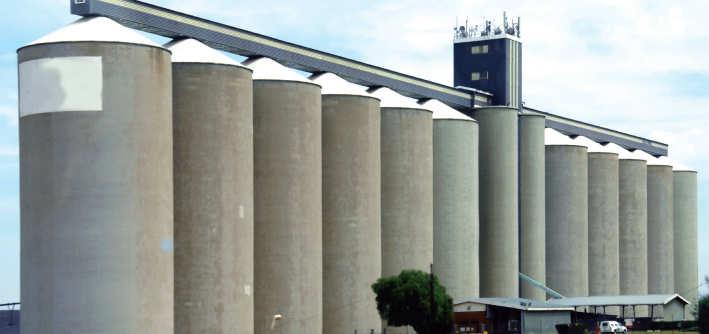
Finally, things are now looking up in the region, notably in Uganda and Tanzania, as Africa’s new hydrocarbon hotspot steps into limelight, writes Martin Clark.
EAST AFRICA’S OIL and gas sector is finally looking like one poised to experience rapid growth. Indeed, it has been a huge decade for the countries of the region after a string of discoveries placed Kenya, Tanzania and Uganda firmly on the global E&P map and brought in investment from some of the world’s major players, including Shell, Total and ExxonMobil.
While Tanzania has had some gas production for many years, East Africa overall has long been deemed something of a backwater in comparison to West Africa, where the continent’s big crude oil producers, Nigeria and
Angola, are located. Their status as sub-Sahara’s premier oil producers may not be under threat just yet, but the countries of East Africa are starting to play catch up.
At the same time, the main economies of the region face many of the challenges testing other more developed areas in terms of transitioning to cleaner fuels and renewables, such as solar power and even the development of hydrogen, longterm. It calls for a delicate balancing act, one that manages the roll-out of hydrocarbons infrastructure alongside environmental concerns and the need for cleaner energy.
Tanzania LNG progress
In some ways, Tanzania has long been a pioneer in Africa’s gas sector, with projects such as Songas, a key provider of
essential electricity to the local grid for 20 years, utilising the country’s own natural gas resources. But it is likely to be dwarfed in scale by the next tranche of projects poised to come on stream, as the country takes on the potential role of a global gas exporter.
There have been several gas discoveries offshore southern Tanzania since 2010, large enough to support a liquefied natural gas (LNG) export plant. Dar es Salaam now estimates Tanzania’s total recoverable natural gas at around 57.54 tn cu/ft.
Progress on the LNG scheme has been slow, but contract talks with key partners Shell and
While deemed something of a backwater in comparison to West Africa, the countries of East Africa are starting to play catch up.”
EAST AFRICA ISSUE 2 2023 • WWW.OI LREVIEWAFRICA.COM 12
The region calls for a delicate balancing act.
Image Credit: Adobe Stock
Equinox hastened during the early months of 2023 and there are now hopes that a final investment decision could be in place by 2025.
The goal is to build an LNG plant in the south-east Lindi region, drawing on offshore gas from Blocks 1, 2 and 4, in a project that could be worth between US$30-40bn. It would be of huge significance for global energy markets, but especially for Tanzania’s own economy as it seeks to diversify and industrialise.
Shell operates Blocks 1 and 4, which hold 16 tn cu/ft in estimated recoverable gas, while Equinor operates Block 2, alongside ExxonMobil, which is estimated to hold more than 20 tn cu/ft.
Uganda oil project
Uganda is another country facing a period of rapid and transformational energy development. For years, the prospect of finding oil was dismissed by most, but that all changed in 2006 with the first commercial discovery in the Albertine Graben region near Lake Albert. A flurry of discoveries followed, but then stalemate blocked any hopes of rapid development.
Finally, in 2022, a milestone agreement was signed by TotalEnergies, CNOOC and the governments of Uganda and Tanzania, paving the way for the US$10bn Lake Albert development project to go ahead. This encompasses the Tilenga and Kingfisher upstream oil projects in Uganda alongside the construction of the East African Crude Oil Pipeline (EACOP) in both Uganda and Tanzania.
Uganda is now expected to start producing in 2025 and to reach a cumulative plateau production of 230,000 barrels per day (bpd) with output transported to the Tanzanian port of Tanga.
The flagship energy project encompasses other aspects too,
which could push up the overall cost to more than US$15bn. That includes the construction of a 60,000 bpd Kabaale Oil Refinery in Hoima, which is expected to transform Uganda’s fuel situation, a country long dependent on foreign imports.
The oil project also includes the extraction of liquefied petroleum gas (LPG) for use in regional markets as a substitute for burning biomass, and the solarisation of the East African Crude Oil Pipe Line (EACOP) pipeline, part of an overall environmental commitment.
Kenya development delays
Kenya has been a pioneer in geothermal energy, which continues today, although, like its near neighbours, it has struggled with maintaining a dependable energy supply. That could be about to change after a series of oil discoveries in the past decade by Tullow Oil, although, for now, the country remains dependent on costly imports.
There are hopes of developing Tullow’s network of finds in the
South Lokichar basin, an area in north-west Kenya, which commenced with the Ngamia-1 oil discovery in 2012. It is working to develop these onshore resources alongside partners Total and Africa Oil, and the government in what it calls ‘Project Oil Kenya’.
An Early Oil Pilot Scheme (EOPS) successfully proved the viability of the wells over a period of two years, with all the required reservoir and production data gathering completed as planned. But progress on the full development scheme has again been slow, and more than a decade later there is still little idea when these fields will enter into full commercial service.
The Tullow team are presently looking to sell a strategic stake in the project to share risk and costs, as well as potentially edge forward development plans.
Moreover, other drilling campaigns have been disappointing, casting a shadow over Kenya’s long-term hopes as a major oil and gas province.

A decade before, Shell and Anadarko achieved a number of discoveries, but later reported that these were uncommercial finds. There are still hopes of targeting offshore prospects, in the hope that Kenya’s potential might mirror the mighty gas discoveries made in Tanzania and Mozambique in the past decade.
That notion was dealt a blow last year, however, with the failure of Eni’s Mlima-1 probe in the Lamu basin.
Either way, Kenya could still benefit from the huge volumes of gas to be processed in neighbouring Tanzania, plus the additional production set to flow out of landlocked Uganda, which will bring with it investment, infrastructure and know how to the whole East Africa region.
EAST AFRICA ISSUE 2 2023 • WWW.OI LREVIEWAFRICA.COM 13
Initiatives like Lake Albert development and Project Oil Kenya are helping the region’s industry advance.”
Other than offshore prospects, Kenya is capable of mirroring the mighty gas discoveries of Tanzania and Mozambique.
Image Credit: Adobe Stock
NEXT BIG LNG DESTINATION
Mozambique has been witness to several gas discoveries that are being funded by major oil giants over the last couple of years.
WITH OVER 180 trillion cubic feet (tn cu/ft) of natural gas reserves in the Rovuma basin in the north of Mozambique, the country is making strides towards becoming a major liquified natural gas (LNG) producer and exporter. The discoveries are divided into two concessions, namely, the Area 1 Mozambique LNG project led by TotalEnergies and Area 4 or (Rovuma LNG), which is coled by Eni and ExxonMobil.
The first two of the six LNG trains that the TotalEnergies’ Area 1 project has in plans reached final investment decision (FID) in 2019. Those are valued at US$23bn. The company had on board a joint venture of contractors spearheaded by Saipem and McDermott to construct the facilities, including dedicated airstrip and port facilities located in the Afungi LNG Park.
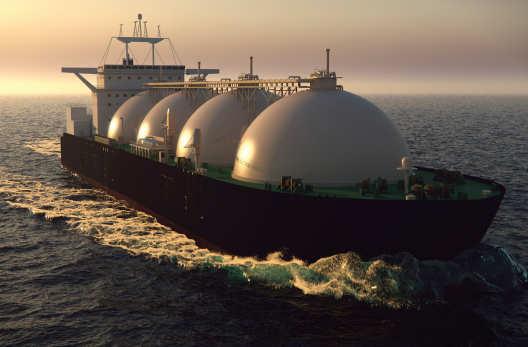
The project is eyeing to tap into the highly prospective Asian and European export markets, while also reserving over 400mn cu/ft gas for domestic uses.
On the Area 4, Eni manages upstream activities, while ExxonMobil handles the construction and operation of LNG facilities onshore located in the Afungi LNG Park. The engineering procurement and construction (EPC) contract involved a consortium that comprised TechnipFMC, JGC
and Samsung Heavy Industries. Area 4 plans also include developing two onshore LNG trains.
In 2017, Eni announced the FID for US$8bn for the construction of six subsea wells connected to a Floating LNG (FLNG) production facility that made successful gas exports in the fourth quarter of 2022.
While offshore gas projects alone provide key opportunities for energy access and job creation, floating liquefied natural gas (FLNG) solutions currently being developed by French-based engineering and
technology company Technip Energies are set to position Mozambique as a global liquefied
natural gas (LNG) producer and exporter. Representing Mozambique’s inaugural offshore LNG project, Technip installed the Coral Sul FLNG facility approximately 80km off the coast of Mozambique. With a production capacity of 3.4 million tons of LNG per annum and with a design life of 25 years, the project is set to trigger newfound growth across the country’s energy sector and reaffirming Technip’s commitment to Mozambique’s gas. In early 2021, the Coral FLNG facility arrived in the country, first gas was introduced
TotalEnergies’ Area 1 project is targeting the Asian and European export markets, while also reserving over 400 mn cu/ft gas for domestic uses.”
MOZAMBIQUE ISSUE 2 2023 • WWW.OI LREVIEWAFRICA.COM 14
Technip applied its latest liquefaction technologies with an APCI DMR process and four LNG loading arms.
Image Credit: Adobe Stock
to the vessel in June 2022 and the first shipment of LNG left the country for Europe in November 2022.
Leveraging its strong expertise and experience, Technip applied its latest liquefaction technologies with an APCI DMR process and four LNG loading arms for sideby-side offloading operations supplied by the company itself, thus positioning the country as a pioneer in this industry while solidifying the company’s own footprint in the African gas market.
In a recent interview, Victoria Kwakwa, World Bank vice president for Eastern and Southern Africa, said that the organisation is reconsidering funding upstream gas projects in Mozambique to support just energy transition.
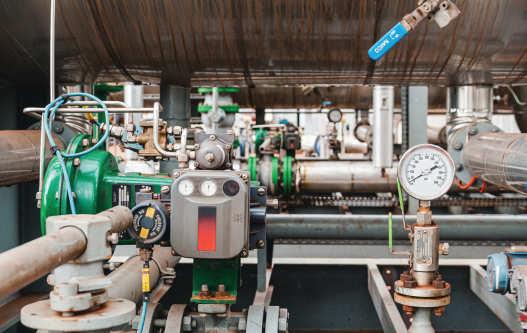
“My sense of Mozambique’s natural gas assets is that it can play an important role for the global transition.
“We are seeing that already most of Mozambique’s gas is being exported to Europe, so Europe is benefiting from Mozambique’s gas, and it keeps Europe also from reverting to less clean energy sources,” said Kwakwa.
While in 2017, the organisation said it would no longer finance such projects after 2019, it noted that “in exceptional circumstances, consideration will be given to financing upstream gas in the poorest countries where there is a clear benefit in terms of energy access for the poor and the project fits within the countries’ Paris Agreement commitments.”
Mozambique’s natural gas production is operated by Sasol (South Africa) in Inhambane Province, which holds proven reserves of 2.6 tn cu/ft. In August last year, the company reported that it is working on future gas supply options, including the possible integration of imported liquefied natural gas (LNG) through Maputo, in
Mozambique. It has already been able to extend the gas supply “plateau” from Mozambique by two years to 2028, following infill well drilling.
The natural gas is produced and processed in Temane and then exported via an 865 km pipeline to South Africa, with a link to southern Mozambique for domestic use.
Additionally, an integrated oil and liquefied petroleum gas project is also in the making. Another project by Sasol, it is valued at over US$700mn. Of that, 13 wells and a liquid propane gas (LPG) production facility comes at an estimated cost of US$1.4bn.
The African Renaissance Pipeline (ARP) project, which will link Mozambique’s vast gas reserves to South Africa via a 2,600 km (1,500 mile)-long onshore pipeline, is expected to expand electricity access throughout the region.
Not only will the ARP carry liquefied natural gas (LNG) to major cities along the pipeline route, but regional extensions will also provide LNG for electricity to Eswatini, Zimbabwe, Zambia, the Democratic Republic of the Congo, Botswana, and Malawi.
According to NJ Ayuk, executive chairman of the African Energy Chamber, in addition to providing an accessible energy source for electricity generation, the ARP is capable of reducing those nations’ oil import bills.
There is interest in almost 60% of the pipeline’s annual capacity, which is estimated to be 18bn cu/m).
The road ahead, however, is not all smooth. In March 2021, TotalEnergies had to discontinue operations on the Mozambique LNG project and declare force majeure to cancel its contracts due to terrorism instances close to the project site.
Recently, TotalEnergies has told media that restart of the project is only possible after three major conditions can be met –
‘assurances regarding the security of Cabo Delgado’, ‘a clear vision of the costs of the project after an interruption of more than two years’, and ‘precise work and commitments from the contractors’.
According to a represenative of the company, resuming the project “is a decision of Mozambique LNG, not a decision of TotalEnergies, which only owns 26.5% of the project”.
While TotalEnergies confirmed that it has seen first hand that conditions on the ground are improving, it is also considering the humanitarian issue, which has been entrusted to Jean-Christophe Rufin, an expert on the subject.
The company also emphasised on the need for reconsidering the costs with a ‘clear vision’ so that it does not go out of hands after the long hiatus.
As the stakeholders are still gauging the merits of the situation from all ends, the principal consultant and head of Middle East Gas Team at FGE, Siamak Adibi’s comment that if construction works resumes by this year, one can expect first gas from the project in 2028 puts it to perspective.
MOZAMBIQUE ISSUE 2 2023 • WWW.OI LREVIEWAFRICA.COM 15
The African Renaissance Pipeline project can expand electricity access throughout the region.”
ARP will link Mozambique’s vast gas reserves to South Africa via a 2,600 km-long onshore pipeline.
Image Credit: Adobe Stock
ADVANCED LOGISTICS INFRASTRUCTURE DRIVES OFFSHORE GROWTH
LAGOS DEEP OFFSHORE Logistics Base
(LADOL), a free zone located at the entry point to Lagos harbour, has emerged as the heavy lift hub of West Africa. The largest base for rig and vessel repair in the region, it now plays a key role in Nigeria’s offshore industry and future plans for growth. It is this logistics expertise that has allowed the industry to become increasingly ambitious in tackling deepwater and ultra-deep ventures.
The Nigerian government is hoping to expand its offshore sector, in part, to counter persistent problems with onshore production. It recently offered seven more offshore blocks to investors covering an area of approximately 6,700 sq km in water depths ranging from 1,150 to 3,100 m.
Total’s mighty Egina field, which commenced first production in 2019, is a template for what Nigeria’s logistics support sector can now achieve. Located 130 km off the coast, in 1,600 m water depths, the field’s plateau production of 200,000 barrels of oil per day (bopd) is equivalent to about 10% of Nigeria’s total output.
The project is based on a subsea production system of 44 wells linked to an FPSO (floating production, storage and offloading vessel) weighing almost 220,000 metric tons. The country’s infrastructure was
extended and enhanced as a result of the project, notably the construction of a 500-m-long dock to assemble the FPSO, which will remain in place for future industrial projects.
Other investments are happening elsewhere too, as Africa’s logistics sector matures.
In Mauritania, SOGECO recently celebrated its first year of operational work on BP’s Grand Tortue-Ahmeyin (GTA) gas project. It was selected to set up a logistical base for storage and transport of the subsea pipes that will link the offshore wells to the FPSO, like the Egina project.
Through the ports of Nouakchott and Ndiago, SOGECO has handled more than 270 calls for 150,000 tonnes of freight transported and more than 100,000 lifting operations. US contractor McDermott is also assisting in the project, which straddles the border of Mauritania and Senegal.
Further along the West African shoreline, AGL (Africa Global Logistics) – formed from MSC’s recent acquisition of Bollore Africa Logistics – is now upgrading its offer to customers across a network that spans 22 port and rail concessions, 66 dry ports and two river terminals.
AGL has just acquired new port tractors at Benin Terminal, operator of the container terminal of the Port of Cotonou, and at Cameroon’s Kribi Container Terminal. The
company is also eyeing opportunity in emerging provinces on the other side of the continent.
Eldon Khuty, AGL’s general manager in Tanzania, highlighted the country’s potential as a logistics hub for East Africa as it evolves its nascent offshore gas industry.

Speaking at a recent TanzaniaEU Business Forum in Dar es Salaam, Khuty highlighted the need for investment in modern logistics and transportation infrastructure, such as ports, railways, and highways, to improve connectivity within the region and reduce the overall cost of doing business.
If Tanzania’s offshore industry is to flourish over the long-term, then it will do so hand in hand with a rapidly-expanding logistics sector.
Africa’s logistics sector is maturing.”
As West Africa’s offshore industry has blossomed over the past 30 years, so too has its logistics and infrastructure, reports Martin Clark.
OFFSHORE LOGISTICS ISSUE 2 2023 • WWW.OI LREVIEWAFRICA.COM 16
West Africa’s logistics expertise has allowed the industry to become increasingly ambitious in tackling deepwater and ultra-deep ventures.
Image Credit: Adobe Stock
BRINGING ON THE RADAR
Oil and gas firms are now increasingly deploying drones to monitor leak detections.
THE VARIOUS ALLIES that sum up the concept of robotics has taken over the complicated infrastructure of the oil and gas industry, simplifying processes beyond imagination. These include autonomous mobile robots (AMRs), automated guided vehicles (AGVs), articulated robots, humanoids, cobots, and hybrids.
Oil and gas firms are now increasingly deploying drones to monitor leak detections in a much safer, easier and cheaper way than before. They are able to access areas that are real close to the assets, which can otherwise be dangerous, at times impossible, for inspection engineers. That helps in covering rather inaccessible data, not to
mention capturing vast quantities within minutes!
According to a data and analytics company called GlobalData, advances in modular and customisable robots is expected to result in growing deployment of robotics in the oil and gas industry. Its thematic report, ‘Robotics in Oil & Gas’, notes that, while robotics has been a part of the oil and gas industry for several decades,
growing digitalisation and integration with artificial intelligence (AI), cloud computing, and Internet of Things (IoT), have helped diversify robot use cases within the industry.
Anson Fernandes, oil and gas analyst at GlobalData, comments, “A huge number of robots are now being deployed in oil and gas operations, including terrestrial crawlers, quadrupeds, aerial drones, autonomous underwater vehicles (AUVs), and remotely operated vehicles (ROVs).”
Robots have applications across the oil and gas industry in various tasks ranging from surveys, material handling, and construction, to inspection, repair, and maintenance. They can be customised for various
tasks to ease the work and improve efficiency. During the planning phases of an oil and gas project, robots can be deployed to conduct aerial surveys, or they can be employed to conduct seismic surveys during exploration. Aerial or underwater drones can be adopted depending upon the project location and work requirements.

“Robotics is a fast-growing industry. According to GlobalData forecasts, it was worth US$52.9bn in 2021 and will reach US$568bn by 2030, recording a compound annual growth rate (CAGR) of 30%.
Robots will be the industry’s growth engine, and the oil and gas sector will greatly benefit from emerging use cases,” said Fernandes.
Growing digitalisation have helped diversify robot use cases within the industry.”
DRONES ISSUE 2 2023 • WWW.OI LREVIEWAFRICA.COM 17
Aerial or underwater drones can be adopted depending upon the project location and work requirements.
Image Credit: Adobe Stock
SINCE THE TURN of the millennium, sub-Saharan Africa had recorded a steady increase in electrification rates which rose from 25.6% in 2000 to a high of 47% in 2019, according to data from the World Bank.
As a result of efforts to reduce the number of people without electricity, the approximately 611 mn who lived without adequate access to power was reduced to around 571 mn in 2019. In keeping here, the continent’s total installed energy capacity increased to 260GW, providing people and businesses a greater sense of security around their energy needs.
While this was certainly heading in the right direction, Africa remained the continent most afflicted by energy poverty, and this trend was only made worse by the onset of the pandemic. These difficulties have subsequently been exacerbated by the outbreak of war in eastern Europe which has hurt consumers and businesses around the world – most acutely in the developing world. Since the outbreak of Covid-19 on the global stage in 2020, the number of people without access has increased for the first time since 2013 and sub-Saharan Africa’s (SSA) share of the global population without access to electricity rose to 77%.
Fundamentally, a lack of reliable access to energy is an
GENSET MARKET HOLDING STEADY

impediment to businesses and individual wellbeing. Over the last year, this has been most keenly demonstrated in one of SSA’s most developed countries, South Africa, which experienced as many as 200 days of loadshedding throughout 2022. While the Government has responded with numerous responses to remedy the situation – such as the National Energy Action Plan to improve the performance of existing power stations and add new generation capacity to the grid – Eskom recorded loadshedding at a record 7,000MW within February 2023 and President Cyril Ramaphosa officially declared a national state of disaster in regards to the energy crisis.
The situation is having a damaging effect on businesses and some of the country’s key industries; data published by the national service Statistics South
Africa found that in December 2022 mining production decreased by 3.5% year-on-year. While the country has dominated headlines around this topic, as it is one of the continent’s most advanced nations, this is a familiar narrative playing out in many of its neighbours across SSA, highlighting the challenge for the African population to secure reliable electricity for personal and business purposes.
Filling the void
In the face of such issues, many companies and households are turning to a reliable fix, diesel generators.
The market around this reliable piece of equipment that has served the continent faithfully for decades took a brief downturn during the pandemic (reflecting a trend experienced in nearly every industry) but has since mounted a quick recovery.
By the first quarter of 2022 imports of diesel generators had increased by 12% year-on-year and were only 3% lower than the pre-crisis level, reflecting a sustained pick-up since the outbreak of Covid-19. At this time, most countries and industry sectors witnessed an increase in demand due to the general market recovery and rising need for electricity.
This pattern of growth has extended throughout 2022, with the latest statistics from PowerGen Pages indicating a continent-wide diesel genset market growth of 16% across 2022. This is contributing to a post-Covid growth that began in 2021 (18%). The African market should continue to grow in 2023 thanks to strong demand in electricity, but in a more moderate way (3%). Market growth is now hampered by longer lead times, and also uncertainty weighing on the economy.
Breaking this down further, generators >500kVA experienced particularly strong growth at +25%, although this must be taken in the context of <500kVA generators having a very strong increase in 2021 at +31% and continued growth throughout 2022. For >2000kVA generators, growth has particularly come from South Africa and Nigeria which has seen sales more than double. This has been particularly encouraged by the
Africa’s diesel genset market is thriving, allowing manufacturers to position themselves for the future by stepping up research into alternative fuels such as hydrogen.
GENSET REPORT ISSUE 2 2023 • WWW.OI LREVIEWAFRICA.COM 18
Cat generator sets at a plant operated by Wentworth Natural Resources supplying power for Mnazi Bay and the city of Mtwara, Tanzania.
Image Credit: Caterpillar, Inc.
manufacturing, mining, oil & gas segments as well as data centres.

Imports from China continued their strong growth in 2022 (40%), following a year in 2021 when they had already increased by more than 30%. This growth is achieved in particular in the power units (375-2000kVA), thanks to the exports of international brands with production units in China. The current relative weakness of the Chinese domestic market is boosting exports, and the ongoing drop in maritime transport prices should support this growth.
While Nigeria still remains by far the most important market in Africa, the strongest growth has come from South Africa with more than 50% in 2022, due to
the very severe disruptions to its grid in 2022 and thanks to the data centre segment which makes it the main African market today. On the other hand, the Algerian market is still not experiencing growth, and the recent regulations requiring generators to be assembled locally should slow down a return to strong growth.
Supplying the market
Maintaining the market is a variety of genset manufacturers and distributors. Among the ranks of those serving customers across the continent are the likes of Perkins, Aksa, Aggreko, Baudouin, Cummins, Volvo Penta, Zest Weg, Teksan Generator, Cantoni Motors, Caterpillar, Kohler Power
Systems, Doosan Portable Power, AJ Power, and many more. Quietly, these companies are ensuring that the required equipment is arriving on location, wherever it is needed across the continent.
Such was the case when Genesal Energy was approached to provide emergency power for a power plant and ancillary services in Kenya. The company responded with a GEN330VI, tailor made to meet the powerhouse needs and effectively supplying backup power to the public facility located in a remote area. The company noted that maximum reliability was needed as the main, ancillary and security systems had to be able to keep running smoothly in the event of a power outage. This
experience is another case of Genesal providing its generator sets – built to withstand the hardest orographic and climatic features – to a continent which it considers special to the business.
Elsewhere, HIMOINSA
Southern Africa provided in rapid timelines a competitive, flexible, turnkey power solution to support a project being progressed by Renergen’s whollyowned subsidiary Tetra4 in South Africa on the assumption that Eskom would not be able to provide the dedicated power supply required to supply the site for a minimum of eight months.
Scan the QR code to download the full, free-to-read report.

GENSET REPORT ISSUE 2 2023 • WWW.OI LREVIEWAFRICA.COM 19
BRIDGING THE DIGITAL GAP
Collaborative partnerships offer a compelling alternative to previous digital transformation attempts, says Adeshina Adebusuyi, regional business development manager at James Fisher AIS.
DIGITAL TRANSFORMATION IN
Africa is advancing in leaps and bounds, with Nigeria leading the charge as home to the highest number of technology hubs in the whole continent. This advancement coupled with global initiatives, such as the Biden Administration’s ‘Digital Transformation with Africa’, will see the continent’s digital infrastructure grow significantly.
Despite this spike, Nigeria’s energy industry is lagging behind its global peers, putting its big ambition, to be a gas-powered economy by 2030, at risk.
Is Nigeria’s decade of gas in jeopardy?
Nigeria is on the cusp of a big oil and gas infrastructure boom, which could see the country finally unlock the economic prosperity residing in its abundant natural resources. This could lift millions out of energy poverty by augmenting domestic supply as well as boosting exports.

Historically, Nigeria has been severely hampered by a lack of oil and gas infrastructure. Progress, however, is finally being made as a result of President Muhammadu Buhari’s ‘Decade of Gas Initiative’, alongside the long-awaited reforms delivered through the Petroleum Industry Act (PIA).
Although the pace has been slow, large infrastructure projects such as the Dangote Refinery, the
614 km-long AKK natural gas pipeline, and several LNG plants are anticipated to be commissioned over the coming months and years. In addition to this, the state-owned refineries in Port Harcourt, Warri, and Kaduna
are also being rehabilitated which will be another boost to the Nigerian economy.
Despite the planned projects, Nigeria’s chequered history with digital technology is in danger of jeopardising this potential success story with many companies becoming disillusioned by digital transformation.
The pitfall of digital distrust
Most oil and gas decision makers will have at least one story to tell of how they were sold a vision of
digital transformation only to be left with an inferior product and no support to assist with implementation. These purchases not only failed to contribute any productivity or financial improvements, but in many cases, did not solve the issues that they were bought to resolve. It’s become an all too common pitfall, engineered by unscrupulous salesmen that are only in it for the win.
Understandably, this has led to distrust and hesitance in adopting new innovations that would have a positive impact,
Nigerian workers have to still struggle with navigating vast data.”
DIGITAL TWINS ISSUE 2 2023 • WWW.OI LREVIEWAFRICA.COM 20
Oil and gas decision makers are plagued with an all too common pitfall of digital distrust.
Image Credit: Adobe Stock
whether on production, maintenance, resourcing, construction, etc. For many workers in the industry, this has created an element of doublethink; they have become hesitant based on past experiences.
While industry leaders elsewhere are benefiting from the latest innovations in digital twins, data analytics and preventive and predictive maintenance, many Nigerian workers are still struggling to piece together their maintenance schedules from incomplete plant plans and records kept in Excel. Employees waste a lot of their time looking for data which has been siloed into several systems and documents, or worse, has not been captured at all, residing solely in colleagues’ memories.

This frustration is only amplified when, year-on-year, they attend the same industry conferences but are left out of conversations for being no further along in digitally transforming their Nigerian operations. This deflated feeling is particularly acute for the globally mobile portion of the workforce who have benefitted from digital transformation firsthand in the United States, Middle East and Europe and previously gained satisfaction from using digital tools to amplify their decision making.
Overcoming digital disillusionment
Without digital transformation, Nigeria will continue to trail its global peers. Although domestic supply and exports will rise, economic prosperity would not be unlocked to the fullest potential. To mend the rift created by digital disillusionment, a new approach to digital transformation is needed.
Collaborative partnerships with an innovative ethos offer a compelling alternative to previous digital transformation attempts.
James Fisher AIS’s
rollout of
its R2S digital twin technology is one example of how Nigeria is benefitting from a different approach.
Partners in Innovation
The key to putting theory into action has been to take a consultative-style process that puts emphasis on solving the company’s problems even where there are no clear solutions – this is how innovation happens. It requires a culture shift away from the traditional business model that relies on quickfire sales of point solutions. Instead, the focus is on establishing long-term partnerships with oil and gas companies to jointly solve their complex issues through consultative engagements; often encompassing design thinking methodologies and data science techniques.
With the investment almost equal for both partners, Nigerian oil and gas companies can have renewed confidence in adopting emerging technologies such as data analytics, digital twin and predictive maintenance. A consultative approach also lends
itself to being scalable and adaptable. Those hesitant to give digital transformation another try can start with a small amount of change – and then scale that change up on the back of success.
For those companies that have taken the leap towards adopting digital twins, they now have the capability to present 2D data, visual data, and real-time data in a real-world context allowing teams from various departments to plan better and swiftly make important operational decisions. Data that was once siloed, outdated and disconnected has become useful, robust and accurate, providing visibility to the remotest of assets
through a visually immersive information experience.
The final piece of the puzzle is to create opportunities for knowledge transfer so that Africa’s oil and gas industry can confidently champion its digital transformation journey on its own terms. To make this vision a reality, James Fisher AIS is delivering a training school in Angola that equips new industry recruits with the digital skills needed to overcome Nigeria’s digital transformation gaps to operate oil and gas assets efficiently. It also opened headquarters in Lagos, expanding the team in Nigeria to give companies direct access to digital transformation experts that are attuned to the region’s specific needs and understand its digital heritage.
Overcoming the gaps in digital transformation through collaborative partnerships will be paramount if Nigeria is to fully benefit from the forthcoming boom in oil and gas infrastructure and be considered as an industry heavyweight on the world stage.
DIGITAL TWINS ISSUE 2 2023 • WWW.OI LREVIEWAFRICA.COM 21
James Fisher AIS’ training school has expanded in Nigeria to give companies direct access to digital transformation experts.”
With digital twins, data that was once siloed, outdated and disconnected has become useful, robust and accurate.
Image Credit: Adobe Stock
A NEW COMPRESSOR COST OF OWNERSHIP MODEL
With the global rise in electricity prices, the energy costs of compressed air have increased to as much as 91% of the total costs of ownership, and operators need to urgently review the efficiency of their system, says Graham Read, product manager Industrial Compressors Europe at Compair.
FOR MANY YEARS, the industry has used a formula to calculate compressed air cost of ownership, comprising capital investment and installation at 10%, maintenance at approximately 8% and energy costs making up the largest proportion at 82%.
This breakdown has served many customers well, enabling them to make informed choices about how to lower running costs. This is especially the case when considering the cost of capital equipment and the potential payback that can be achieved by investing in an energy-efficient machine.
However, customers now need to reevaluate the way that they assess their compressed air energy costs as Read explains:
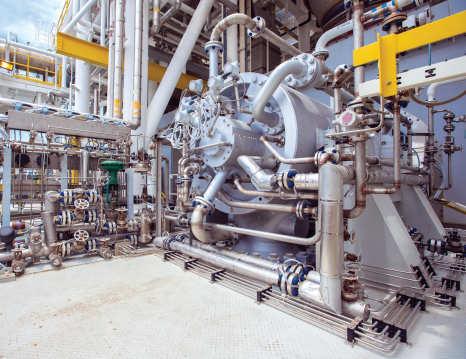
“Total running costs over the last 10 years for a 160kW compressor have more than doubled. Put simply, for every 100,000 Euros spent on compressed air previously, around 82,000 Euros of this was the energy costs. Now, this figure has risen to 91,000 Euros – with energy costs doubling in the last two years alone.
“The good news is there are numerous high performing, energy-efficient compressors available on the market, which can help reduce a site's reliance on electricity considerably, such as our new L160e-250e range."
The new L160e, 200e and 250e kW FourCore compressor range offers all the capabilities of an oil lubricated two-stage compressor, but with only the footprint of a single-stage unit. This compact, two-stage airend uses four gears rather than three, to deliver flexible rotor speed adjustment at both low and high pressures, as well as the best possible performance at different discharge pressures and shaft speeds.
When compared with previous single stage compressors in this size range from CompAir, the new models are up to 8% more efficient, offering a best-in-class oil-lubricated solution
that can help significantly reduce energy costs.
In addition, integrated heat recovery is offered as an option on the new range. By recycling the heat generated from a compressor, businesses can repurpose this energy to heat water, for space heating, or for application processes in other areas of the installation.
Read continues, “While not every site will have the available capital expenditure to invest in a new energy-efficient compressor, significant savings can still be made by adopting a 'measure, manage and improve' approach.
“CompAir offers an air assessment service which looks at all aspects of a compressed air system's performance, including power and flow data, pressure measurements, leak detection and heat recovery to name a few.
“Using data logging, precise measurements
are taken to give a comprehensive overview of energy performance. Suggestions can then be made on potential equipment upgrade or investment, through to simple equipment optimisations and low-cost elements, such as fixing leaks, reducing pressures and switching off compressors when they are not in use.
“The industry is becoming increasingly concerned about the substantial increase in electricity prices. By understanding how the cost of ownership balance has shifted, and adopting a system-based approach, it is clear that customers can achieve rapid payback on any investment made."
To find out more, please visit https://www.compair.com/en-gb/sustainablecompressed-air
COMPRESSORS ISSUE 2 2023 • WWW.OI LREVIEWAFRICA.COM 22
Compressors are widely used in the oil and gas industry.
Image Credit: Adobe Stock
BACKBONE OF OIL AND GAS INFRASTRUCTURE
FABRICATION IS WHAT holds together the many equipments that make up the oil and gas industry. Prominent oil and gas infrastructures such as fixed platforms, compliant towers, semi-submersible platform, jackup drilling rigs, drill ships, floating production systems, tension-leg platforms, and gravity-based structures and spar platforms require steel legs for support. These, in turn, are made by structural steel fabricators.
Modern engineers use computer aided design (CAD) to first draw an outline of the project. Then comes the stage of cutting the plate and sheet metal, a skill that demands high concentration as it has no scope for trial and error.
The next stage is forming, which can involve anything from folding, bending, stamping or punching holes, machining, to get the desired shape. Nest comes assembling or the process of welding.
According to South Africabased Efficient Engineering’s business unit manager of the pressurised equipment division, Gerhard van Zyl, since the oil and gas industry adheres to the strictest technical requirements, the company has always positioned itself in line with the highest standards and protocols. This is supported by its fully integrated ISO 9001 quality
certification and ISO 45001 occupational health and safety management system.
“From preliminary design through to fabrication and delivery, our customers are
confident in our ability – having experienced our commitment to service levels for many years now.
“We have the infrastructure to conduct almost all tasks in-house and can therefore control quality and lead times very closely. We also source the materials – which are often specialised to suit specific applications – from trusted local and overseas vendors.”
In the pressurised equipment segment, welding skills and compliance are vital to ensuring quality and safety, he emphasises. Efficient Engineering also has internationally qualified welding
engineers, recognised by the Southern African Institute of Welding, who conduct the prerequisite in-process welding inspections during fabrication. Its well-equipped Germiston premises includes column and boom welders that can operate up to six metres high and with a six metre reach and automatic stateof-the-art orbital tube-to-tube sheet welding equipment, as well as non-destructive hydraulic testing and coating applications in its dedicated, environmentally friendly grit blasting and painting facilities. certification.
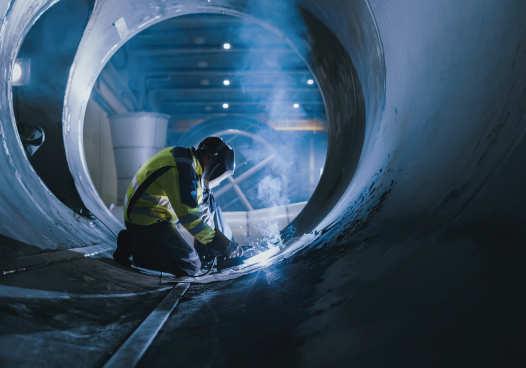
Welders from Efficient Engineering are recognised by the Southern African Institute of Welding.”
In the pressurised equipment segment, welding skills and compliance are vital to ensuring quality and safety.
FABRICATION ISSUE 2 2023 • WWW.OI LREVIEWAFRICA.COM 23
The company includes column and boom welders that can operate up to six metres high.
Image Credit: Adobe Stock
ENI SUSTAINABLE MOBILITY and the Spinelli Group, a leader in the field of integrated logistics, have signed a two-year contract to power the group's fleet with HVOlution, a diesel fuel produced from 100% renewable raw materials. The Spinelli Group's fleet includes more than 300 heavy-duty vehicles, of which 150 are latestgeneration Euro 6d trucks compatible with pure biofuel. The supply of biofuel to the Spinelli Group is made possible by Eni Sustainable Mobility's network of retail outlets. The product is now available in 57 service stations and by the end of the month it will be available in 150 sales points in Italy.
The agreement is key to Eni Sustainable Mobility and shows how the company can support heavy transport players like the Spinelli Group on the path towards decarbonisation. Eni Sustainable Mobility has been operating since January and combines bio-refining, biomethane and the sale of mobility-related products in more than 5,000 service stations in Italy and abroad.
The venture aims to evolve into a multi-service, multi-energy company, generating and unlocking new value for the decarbonisation of the transport sector and providing services to people on the move.
Spinelli was founded in 1963 and manages the entire supply chain for the container sector,
ENI GOES GREEN WITH HVOLUTION
from the arrival of containers in ports to their delivery to the final customer, offering shipping companies integrated solutions including multimodal transport, storage and customs forwarding activities.
The agreement for the supply of HVOlution represents a key step for the group, as this type of
biofuel can contribute to immediately decarbonise the transport supply chain. It will support the group in developing its ESG policies for a zeroemission future and to reach the UN’s Sustainable Development Goals (SDGs), in particular SDG 12 (responsible consumption and production) and SDG 13 (climate action).
The supply of HVO diesel to the Spinelli Group's vehicles is handled through Multicard, Eni Sustainable Mobility's fuel card system designed for small, medium and large hauliers. Depending on their needs, Multicard provides a tailor-made offering for the supply of all
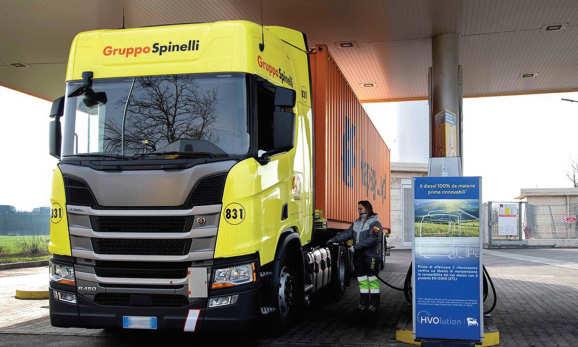
energy carriers available at Eni service stations, including the new HVOlution fuel.
HVOlution is a biofuel produced from waste raw materials, vegetable residue and oils produced from crops that not in competition with the food chain. They are supplied to Eni through a network of agri-hubs currently being developed by the company in several African countries.
These raw materials are processed in Eni's bio-refineries in Venice and Gela, where HVO (Hydrotreated Vegetable Oil) diesel biofuel is produced thanks to Eni's proprietary Ecofining technology.
HVOlution is a diesel fuel produced from 100% renewable raw materials.”
The energy giant has collaborated with the Spinelli Group to power the latter’s fleet with biofuel.
TRUCKS ISSUE 2 2023 • WWW.OI LREVIEWAFRICA.COM 24
150 of the Spinelli Group's latest generation Euro 6d trucks are compatible with pure biofuel.
Image
Credit: Eni
IN TODAY’S DIGITAL world, the energy sector has emerged as a primary target for cybercriminals. Given that energy systems are the backbone of economic activity and heavily reliant on complex, around-theclock digital infrastructure, energy companies’ Intellectual Property (IP) and critical data have never been more vulnerable, while rising prices and geopolitical motives are other factors behind frequent attacks.
More must be done to combat cyber threats, and companies can contribute by taking adequate steps to protect themselves.
“Although many benefits accompany digital transformation, embracing the trend is not without its discrepancies – a fact substantiated by the volume of cyberattacks being witnessed within the energy sector,” explained Antoine Harb, team leader, Middle East, Kingston Technology. “The increasing threats industry incumbents are experiencing can prove detrimental should their security systems be breached, with potential repercussions ranging from reputational damage and financial losses to strained client relationships and regulation compliance shortcomings. As such, ensuring security systems are secure and regularly undergo audits is paramount.”
With IP and critical data protection a non-negotiable
PROTECTING AGAINST CYBER THREATS
necessity for energy companies, Kingston Technology maintains that encrypted threat protection solutions can help bridge security gaps, mitigate risks, and complement organisations’ security strategies, providing a robust surface of protection through an easy-to-integrate encryption process.
By carrying out a comprehensive IT security assessment across their entire device portfolio, energy providers can verify their current security status. Should they be categorised as ‘high risk’, they can pursue corrective action, establishing policies and deploying security solutions as part of a revised endpoint device management strategy.
“Energy companies must be supported in their IP and data security endeavours and acquire solutions to accommodate their offsite teams,” said Harb. “Encrypted
devices and USB drives are viable, proven solutions for boosting the required level of security. Backed with unique customer Product IDs, they are manufactured to be compatible solely with a company’s unique end-point management software, offering reliable protection and a simple, secure way to preserve confidential energyrelated information.”
Benefits aside, hybrid working models adopted by many energy providers are susceptible to cyber infringements. While office-based personnel connected to network servers often use SharePoint or similar cloud-based sharing tools to save and share data, approximately 40% of workforces in off-site, field-based jobs require access to data outside the internal Wi-Fi network.
Easy-to-use encrypted portable devices such as USB drives and external SSDs are therefore essential for preventing potential breaches, with solutions available that enable companies to manage such devices through their own endpoint management software. Encryption features ensure unauthorised devices cannot infiltrate an organisation’s network, thereby boosting security and eliminating potential risks from the equation. A simple yet effective approach is to whitelist USB storage devices by utilising their respective Vendor Identifier (VID) and Product Identifier (PID) values.
With complete control over what devices and drives can be used within their organisational framework, as well as newfound audit and IP and data protection capabilities, energy providers can also be assured of their compliance with regulatory standards, which is also essential given the costs of data breaches.
The average cost of data breaches for critical infrastructure organisations – including those in the energy sector – is estimated to be US$4.82mn globally, with 28% having experienced a destructive or ransomware attack, according to a recent IBM report.
“For MENA-based energy sector players, the need to reinvigorate their respective security postures and protect IP and critical data with the latest highly-capable solutions has never been more urgent,” added Harb. “It is important to appreciate that the region has become a hub for cyberattacks and infringements as nations and industries become increasingly digitalised to achieve economic diversity. Energy is no exemption and – with the wider sector integrating more technologies for operational efficiency and energy transition purposes – organisations are compelled to explore available options and address threats as part of an in-depth defense approach.”
To learn more, visit the website at www.kingston.com
By carrying out a comprehensive IT security assessment across their entire device portfolio, energy providers can verify their current security status.”
Kingston Technology Europe Co LLP, an affiliate of Kingston Technology Company, Inc., a world leader in memory products and technology solutions, is calling on energy providers to counter emerging threats by deploying the latest security solutions.
CYBER SECURITY ISSUE 2 2023 • WWW.OI LREVIEWAFRICA.COM 25
GEOPHYSICAL DATA MANAGEMENT FOR OIL AND GAS EXPLORATION
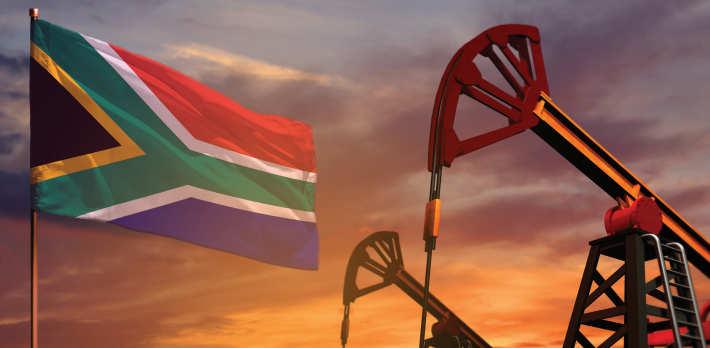
GEOPHYSICAL DATA
MANAGEMENT ensures that geophysical data is stored securely and is easily accessible to researchers, scientists, and other stakeholders who need to use it. It involves the application of best practices and standards to ensure the integrity, accuracy, and reliability of geophysical data.
Oil companies use a variety of techniques to manage geological or subsurface data, which includes geophysical data such as seismic data, well logs, and other geological data. The management of geological or subsurface data is critical to oil companies as it is
used to identify and evaluate oil and gas reserves and determine where to drill. Here are some examples of how oil companies use geophysical data:
1. Exploration: Geophysical data management plays a crucial role in oil exploration by helping companies locate potential oil and gas reserves. Geophysical surveys, such as seismic surveys, provide detailed images of the subsurface to help geologists and geophysicists identify areas that may contain oil and gas.
2. Reservoir characterisation: Once a potential oil and gas reservoir has been identified, geophysical data management is used to determine the characteristics of the reservoir, such as its depth, size, and shape. This information helps companies optimise production
by designing wells and drilling plans that can access the maximum amount of oil and gas.
3. Drilling optimisation: Geophysical data management is also used to optimise drilling operations by providing real-time information on the subsurface during drilling. This helps companies make adjustments to drilling plans to avoid drilling hazards, such as unstable formations, and increase drilling efficiency.
4. Risk management: Oil companies use geophysical data management to assess the risk associated with drilling in certain areas. By analysing geophysical
With much of its basins unexplored, South Africa offers a highly profitable opportunity for oil and gas exploration.”
Africa aims to boost energy security by opening new oil and gas exploration opportunities, writes Minhaj Zia.
GEOPHYSICAL DATA ISSUE 2 2023 • WWW.OI LREVIEWAFRICA.COM 26
Africa looks to open up its upstream market to boost opportunities for energy security.
Image Credit: Adobe Stock
data, companies can identify potential hazards, such as fault zones, and plan drilling operations accordingly to minimise risk.
In Africa, despite the efforts of environmental activists to restrict the monetisation of South Africa’s oil and gas resources, the county’s Department of Mineral Resources and Energy (DMRE) has decided to move forward with plans to open key onshore and offshore licencing rounds in an effort to put an end to load shedding. With the dire energy crisis in the country and restricted global energy supply chains, South Africa is looking open up the upstream market to boost opportunities for energy security and self-sufficiency, both of which are critical for creating a globally competitive economy.
With much of its basins unexplored, South Africa offers a highly profitable opportunity for oil and gas exploration. The Department of Mineral Resources and Energy (DMRE), under the leadership of Hon. Minister Gwede Mantashe, is hoping to replicate the successful upstream operations in Namibia's shared Orange Basin, where significant oil and gas discoveries were made in early 2022. To pursue other promising prospects across the nation, the DMRE has launched an ambitious agenda that includes onshore and offshore licensing rounds. This plan will be implemented following the passing of the Upstream Petroleum Resources Development Bill.
“South Africa can no longer afford to leave its oil and gas resources in the ground. As discussed, during African Energy Week, Oil and natural gas represent the solution that the country needs. Environmental activists that continue to block the development of these resources, continue to block the development of the very economy they live in. The drive by the DMRE and Hon. Gwede
Mantashe should be commended, as the opening up of licensing rounds and acreage will deliver South Africa into a new era of energy security and resilience that many countries across the world so urgently seek,” stated NJ Ayuk, executive chairman of the African Energy Chamber (AEC).
A recent innovation in onshore seismic surveys is STRYDE’s cableless receiver technology and their fast-track data processing services, capable of delivering highresolution images of the subsurface at a faster and significantly reduced price point. The seismic sensor system is lightweight, significantly lower-priced, and agile, enabling high-density, large-scale seismic surveys to be a viable option for oil and gas operators. With more than 400,000 STRYDE Nodes being used in the Middle East over the last two years, it has been proven to enable the seismic contractors to take advantage of vastly improved survey operational efficiencies, lower crew operating costs with much less logistical constraints, while minimising exposure to HSE risks. The end clients can benefit
from using the STRYDE system with higher-resolution imaging of the subsurface at reduced costs.
Last year, STRYDE expanded its presence in African exploration by entering a sevenfigure agreement with Polaris Natural Resources, a Canadian seismic company, to procure a 13,000-node system capable of acquiring high-density subsurface data. This cuttingedge technology will facilitate cost-effective and efficient oil and gas exploration in Africa.
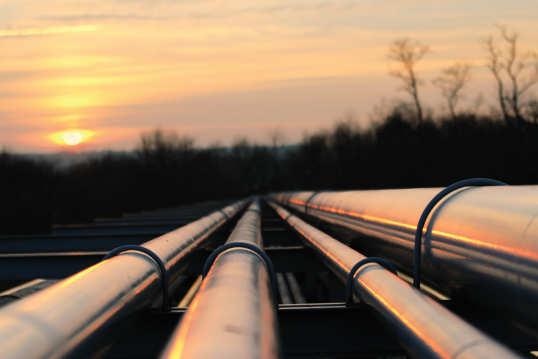
The agreement follows the acquisition of high-density 2D seismic data from STRYDE's nodes, which were obtained from Zimbabwe earlier last year. The data proved instrumental in identifying promising mature prospects in the Cabora Bassa Basin, located in northern Zimbabwe. This basin is
considered the most extensive unexplored conventional oil and gas prospect on the African continent. Currently, the drilling of the Muzarabani-1 well is ongoing in this area.
Geophysical data management is a crucial tool used by oil companies to identify and evaluate potential oil and gas reserves. It plays a key role in exploration, reservoir characterisation, drilling optimisation, and risk management. Despite environmental concerns, the South African government has decided to pursue onshore and offshore licensing rounds to explore its untapped oil and gas resources to address the country's energy crisis and boost its economy. Newer innovations, such as STRYDE's cableless receiver technology, offer cost-effective and efficient options for seismic surveys, which can provide higherresolution images of the subsurface to identify potential oil and gas reserves. The successful exploration of Zimbabwe's Cabora Bassa Basin demonstrates the potential of unexplored areas in Africa for oil and gas exploration.
GEOPHYSICAL DATA ISSUE 2 2023 • WWW.OI LREVIEWAFRICA.COM 27
South Africa can no longer afford to leave its oil and gas resources in the ground.”
The transportation of oil using pipelines in Africa.
Image Credit: Adobe Stock
REDUCING FLARING TO MEET THE GLOBAL SUSTAINABILITY AGENDA
Exploring alternative technologies such as HIPPS can cut down emissions, explains Mohamed Salman - SIS business development manager of Middle East and Africa at Emerson Automation Solutions.
GAS FLARING IS the process of burning natural gas that is extracted alongside oil. This has been a common practice for over 160 years since the beginning of oil production.
Flaring outlook
Gas flaring is done for various reasons including economic and market limitations, inadequate regulation, and a lack of political will. Flaring is used as a safety measure to prevent the accumulation of gases in equipment.

The Middle East and North Africa region is the secondlargest flaring region in the world, flaring an estimated 50 billion cubic meters (bn cu/m) of gas annually, with Russia and the Caspian region being the largest
flaring region, flaring almost 60 bn cu/m. In contrast, subSaharan Africa flares approximately 35 bn cu/m of gas per year.
Dire environmental costs
Flare designs are usually intended to facilitate complete combustion, which helps reduce the amount of direct hydrocarbon emissions released into the atmosphere. Flaring allows operators to safely manage sudden and significant pressure fluctuations by burning off excess gas and reducing pressure in their equipment.
However, this process results in excessive emissions of carbon dioxide and methane into the atmosphere, contributing to the depletion of the ozone layer, acid rain, and ocean acidification.
Since the industrial revolution, ocean pH levels have been decreasing, and this, in turn, leads to increased acidity in seawater. Global warming is also a significant consequence of the increased release of carbon dioxide and methane into the atmosphere resulting from oil fields flaring. The NOAA Global Monitoring Lab reported a
Sub-Saharan Africa flares approximately 35 bn cu/m of gas per year.”
FLARING ISSUE 2 2023 • WWW.OI LREVIEWAFRICA.COM 28
The Middle East and North Africa region is the second-largest flaring region in the world.
Image Credit: Adobe Stock
record-high global average atmospheric carbon dioxide of 414.72 parts per million (ppm) in 2021, despite the COVID-19 pandemic's economic slowdown. The steady yearly increase in carbon dioxide levels is alarming and highlights the intensification of the natural greenhouse effect caused by human activities.
Carbon dioxide's ability to absorb heat and radiate it in all directions leads to a rise in global temperature. According to the NOAA Global Monitoring Lab, carbon dioxide alone contributed to around two-thirds of the overall warming effect caused by human-generated greenhouse gases in 2021.
Approach to reducing emissions
While eliminating flaring may not be practical, exploring alternative technologies that reduce the dependence on flaring could be a valuable consideration. One effective approach to reducing flaring emissions is to decrease the demand for flaring. Although flaring is necessary for safety and emergency situations that require pressure release from the process, there are now several methods and technologies available to manage highpressure situations and prevent
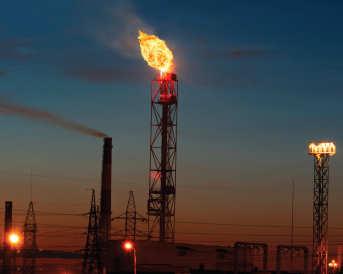
pressure buildup by isolating downstream equipment from the high-pressure source.
One such technology is the High-Pressure Integrity Protection System (HIPPS), which uses electronic and programmable systems to provide a high level of safety integrity. HIPPS is designed to prevent overpressure by shutting off the source and containing the pressure in the upstream side of the system, creating a barrier
between the high-pressure and low-pressure sides of the process plant. This tight shutoff not only prevents loss of containment but also eliminates fugitive emissions, making HIPPS the ‘last line of defense’ for safety.
A typical HIPPS system consists of two or three final elements in the series and can shut down within two to three seconds for gas and six to eight seconds for liquids, depending on pipeline pressure, flow rate, diameter, and class. Pressure sensing systems detect the peak pressure surge and initiate the shutdown sequence, with three sensors connected to the logic solver. If the predefined pressure parameters are exceeded, the logic solver shuts down the final elements and the process.
Holistic solution
A solution for HIPPS that covers all aspects of design, construction, installation, and
operation is necessary for comprehensive safety. This solution comprises several components, including solenoids, actuators, DVC controllers, pressure transmitters, DCS logic solvers, and a valve of the user's choice. All components are tested and certified by safety consultants to ensure they meet safety standards. This solution meets the end-user's specifications and avoids conflicts during validation that could lead to delayed startups.
In today's world, achieving sustainability and reducing carbon footprint is crucial, especially with net zero targets driving the agenda. Compliance with ISO 50001, the global standard for energy management systems, sets high benchmarks and may make some companies eligible for government financial support.
Emerson's portfolio offers intelligent measurement and control solutions, including the Industrial Internet of Things (IIoT), sustainable products, and software that provides actionable insights to reduce emissions and maximize energy management.

FLARING ISSUE 2 2023 • WWW.OI LREVIEWAFRICA.COM 29
HIPPS is the last line of defense for safety.”
There are several technologies available to manage high-pressure situations and prevent pressure buildup by isolating downstream equipment from the high-pressure source.
Image Credit: Adobe Stock
HIPPS uses electronic and programmable systems to provide a high level of safety integrity.
Image Credit: Adobe Stock
SLBʼs geopolymer system, EcoShield, decarbonises well construction
SLB HAS INTRODUCED the EcoShield geopolymer cementfree system that minimises the CO2 footprint of a well’s construction. This innovative technology eliminates up to 85% of embodied CO2 emissions compared with conventional well cementing systems, which include portland cement. The EcoShield system has the potential to avoid up to 5 mn metric tons of CO2 emissions annually – the equivalent of removing 1.1 mn cars from the road each year.
“Decarbonising the well construction process while ensuring safety and performance standards is critical to our industry’s pathway to net zero,” said Jesus Lamas, SLB’s president of well construction. “The cement-free EcoShield system is a breakthrough that delivers
industry-standard zonal isolation capabilities while significantly minimising impact from upstream oil and gas production.”

In addition to its embodied CO2 emissions, portland cement creates significant transportationrelated emissions from manufacture to deployment. The EcoShield system uses locally sourced natural materials and
industrial waste streams in its composition, making this a far more sustainable well integrity method.
The cement-free system can be deployed throughout various phases of the well life cycle including abandonment. It can also be deployed across a range of field applications, including corrosive environments.
KPSʼ HDPE pipes enables interstitial monitoring
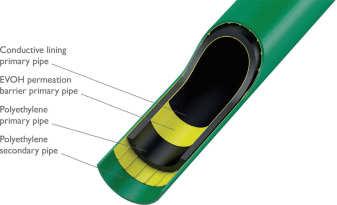
KPS PART OF OPW, a Dover company), a global innovator in HDPE (High Density Polyethylene) piping, has introduced the 6” (160/200mm) double wall conductive HDPE piping system. It has been designed to combine KPS piping’s industry-leading safety and installer-friendly qualities with a high flow rate of up to 2,500 litres per minute to meet demand from applications including depots, fuel distribution, ports, mining, rail, data centres and many more. A conductive inner layer allows static electricity to safely dissipate into the earth, while a secondary pipe provides an extra layer of protection and enables
interstitial monitoring.
In the Permian Basin, Pioneer Natural Resources successfully deployed SLB’s novel cement-free technology on an 18-well field testing campaign and continues with its use. This successful pilot programme in North America proved the performance of this unique cement-free solution while substantially reducing the CO2 footprint in the well construction process. Field trials validated the ability of the technology to fit within standard oilfield cementing workflows without major changes to the design process, onsite execution, or post-job evaluation.
The EcoShield system is part of the SLB Transition Technologies portfolio, which includes proven technologies that drive high performance while reducing CO2 emissions.
“When fuel flows through a pipe, it creates friction which creates an electrical charge on the pipe wall,” said Staffan Helleday, technical director, KPS.
“If the material is not conductive, the charges (free electrons) can’t flow anywhere and consequently accumulate until a rapid discharge can occur: a spark!
“In 1997 we developed the world’s first conductive HDPE piping to combine the lightweight, corrosion-free benefits of HDPE with the conductive safety of metal. A conductive inner layer allows static electricity to dissipate into the earth.
“As future fuels containing oxygen which generate more friction are increasingly used, conductive piping becomes ever more important,” he concluded. The innovative conductive system consists of a 160mm primary pipe and a 200mm secondary pipe, providing an extra layer of protection and enabling interstitial monitoring. Suitable for sensitive liquids such as fuel and chemicals, including petrol, diesel, biodiesel, ethanol blends, AdBlue, Jet-A1, alcohols, acids and other chemical products. The system is approved to EN 14125, ATEX 137, EN 13463-1, as well as many other country and fuel-specific standards.
The new 6” system is engineered for installers to reduce cost and build time. The complete range of fitting and components are electrofusion welded, with no butt welds needed, and the range is supported by the KPS technical team, including training and certification (classroom and on-site).
ISSUE 2 2023 • WWW.OI LREVIEWAFRICA.COM INNOVATIONS 30
KPS’ 6” (160/200mm) double wall conductive HDPE piping system.
Image Credit: Adobe Stock
Image Credit: KPS
The innovative technology eliminates up to 85% of embodied CO2 emissions.
EthosEnergy cements long-term partnership with GPSC
ETHOSENERGY HAS BEEN awarded a Long-Term Service Agreement (LTSA) for gas turbine maintenance, inspection, and repair services by Global Power Synergy Public Company Limited (GPSC) – one of the leading power generation companies in the Asia-Pacific region (APAC). The LTSA runs for 12 years and starts in Q1 of 2023.
The LTSA covers eight GE Frame 6B gas turbine units at two cogeneration power plants in Rayong: Central Utility Plants 1 and 2 (GPSC CUP-1 and GPSC CUP-2).
These plants use natural gas as a main fuel and supply power and steam to the Electricity Generating Authority of Thailand (EGAT) and industrial customers located at the Map Ta Phut Industrial Estate. Under the LTSA, EthosEnergy will also provide generator services for the plants.
Since 2005 EthosEnergy has also had an LTSA with Glow Energy Public Company Limited and Glow SPP2 Company Limited, affiliate companies of GPSC.
“This key win shows the value that our customers place on our value-add approach, putting the customer at the heart of everything we do,” said James Edmondson, commercial director at EthosEnergy.
“We built an inclusive team around this bid who were relentless in ensuring we hit all of the customer’s key drivers. The team’s collaborative approach and willingness to listen to new ideas meant we could simplify complex problems and focus on what really mattered to our customer,” he concluded.
Amarinth secures order from Azku Global Services
AMARINTH, A WORLDLEADING, net-zero designer and manufacturer of low lifecycle cost centrifugal pumps and associated equipment, primarily for the offshore and onshore oil & gas industries; nuclear and renewable energy generation; defence; desalination; process and industrial markets, has secured an order from Azku Global Services for US$200K of API 610 OH1 pumps destined for the Iraqi Ministry of Oil operated Majnoon Oil Field.
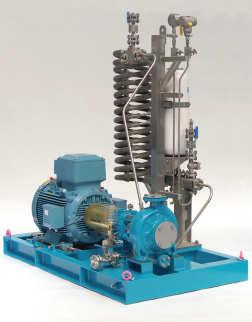
This is Amarinth’s first order from Azku Global Services and comes off the back of numerous projects that Amarinth has successfully delivered into Iraq. The Majnoon Oil Field is a super-giant oil field located 60 km from Basra in southern Iraq and is one of the richest oil fields in the world. The field is 52 km-long, 15 km-wide, includes 13 different oil and gas reservoirs, and has an estimated 38 billion barrels of oil in place.
The API 610 12th edition OH1 pumps are for condensate transfer duties and include the latest API 682 4th edition Plan 53B seal support systems along with Amarinth mobile top-up units. Specified for ATEX Zone 1 use, the pumps are required on an aggressive 30-week delivery. On completion, they
will be inspected and witness tested by Bureau Veritas, and supplied with a full legalised Iraq documentation package.
ABB Ability SCADAvantage allow remote monitoring vital pipeline parameters
ABB INDIA HAS delivered integrated automation and control solutions to enable the safe, secure, and reliable operation of the 130-kilometer Indo-Bangla Friendship Pipeline, which will carry diesel from India to Bangladesh. The cross-border pipeline was jointly inaugurated by Indian Prime Minister, Narendra Modi, and Bangladesh Prime Minister,
Sheikh Hasina, on 18 March. With a potential capacity of one million metric tonnes per annum, it will enable Bangladesh to access large volumes of energy to meet its growing domestic demand.
ABB Ability SCADAvantage, remote terminal units, and a leak detection system will allow Numaligarh Refinery Ltd (NRL) to remotely monitor and control vital pipeline parameters such as flow, pressure, and temperature, as well as detect leaks. ABB solutions will provide real-time data on the performance of the pipeline network by generating reports, history sheets, critical messages and alarms, all of which will maximise efficiency and safety.
The diesel will be transported from NRL’s marketing terminal, at Siliguri, to the Bangladesh Petroleum Corporation's oil depot in Parbatipur. Approximately six km of the pipeline – which is the first of its kind between the two countries – will be within the territory of India, with the remainder within the territory of Bangladesh.
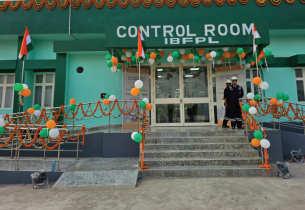
NEWS ISSUE 2 2023 • WWW.OI LREVIEWAFRICA.COM 31
Amarinth API 610 OH1 pump with API 682 Plan 53B Seal Support System
ABB automates first India-Bangladesh cross-border oil pipeline
Image Credit: Amarinth
Image Credit: ABB India
LIKE MOST COUNTRIES across the continent, Zambia has experienced its fair share of energy-related issues. In terms of access to electricity, in many ways the lifeblood of businesses operating in the country and a contributor to general wellbeing, rates have been steadily increasing in recent decades but have slowed since the outbreak of the pandemic – a trend largely reflected across sub-Saharan Africa.
At the start of 2023, alarm bells were also raised when water levels at the Kariba Dam dropped dramatically in light of changes in rainfall patterns. This resulted in reduced generation from the facility – which has an installed capacity of 1,080MW – ultimately threatening enhanced load shedding across the country.
While such stories make for concerning reading, state-owned utility, ZESCO, has sought to change the narrative around the country’s relationship with energy. To do so, the power company, which produces around 80% of electricity consumed in Zambia, launched the Strategic Plan in February 2023.
The newly unveiled 10-year rolling plan targets the implementation of a refreshed core ideology and a US$6bn project investment across the utility’s value chain of generation, transmission, distribution and supply.
The initiative is guided by five objectives which include to:
6 Achieve customer satisfaction and win customer confidence and loyalty;
6 Be a financially sustainable organisation that balances the needs of its stakeholders;
6 Expand the generation, transmission and distribution systems guided by an integrated resource plan;
6 Have an effective maintenance regime for generation, transmission and distribution systems;
6 Align human capital to business objectives. At the launch ceremony, ZESCO managing

A NEW DAWN FOR ZAMBIA
director, Victor Mapani, called for a mindset shift and appealed to all employees to embrace the company’s new core ideology which espouses integrity, teamwork and innovation among its corporate values. In embarking on this initiative, ZESCO is aiming to reorganise and transform into a commercially viable business with a sound reputation and enhanced power generation portfolio, ultimately for the betterment of the country. Vickson Ncube, ZESCO board chairman, wrote in the company’s Strategic Plan, “The journey ahead is not easy, but it must be travelled with utmost determination and perseverance.”
Speaking of the current make-up of energy generation for Zambia, and how has ZESCO sought to end load shedding in the country despite a growth in energy demand, Ncube said that Zambia has 3,644MW of installed electricity generation capacity, of which 86% is hydro based.
In the medium-term, ZESCO is focused on expanding its power generation mix by investing in renewable energy sources such as solar and wind. The target is to bring onboard a renewable energy mix composed of a minimum of 800MW Solar, 500MW wind and
500MW hydro power energy in the next 10 years.
The capacity and energy of all the projects combined when implemented should be adequate to ensure the reliable operation of the Zambian power system.
According to Ncube, ZESCO has identified a few challenges and are addressing them. These include:
*Below cost electricity tariffs which have exacerbated the problem of tariff differential between the cost of buying electricity from IPPs and ZESCO’s selling price, thereby negatively affecting the financial situation of the corporation. ZESCO has applied to revise the electricity tariffs using the phased in approach and multi-year tariff framework. ZESCO has further engaged Independent Power Producers (IPPs) in renegotiating tariffs with notable success with Maamba Collieries Limited and Itezhi-Tezhi Power Corporation (ongoing and on course).
*High and unsustainable levels of debt to IPPs, lenders and other creditors (suppliers of goods and services). ZESCO is working towards restructuring long term Government guaranteed debt, conversion of some of its
ZESCO has unveiled a Strategic Plan to revitalise the country’s energy sector.
POWER GENERATION ISSUE 2 2023 • WWW.OI LREVIEWAFRICA.COM 32
The unveiling of ZESCO’s Strategic Plan.
Image Credit: ZESCO
debt to equity and engaging the Government to honour their portion of the debt.
*High outstanding receivables from Government institutions and the mines. ZESCO is currently engaging the Government and mines for debt swaps and sustainable methods of liquidating these receivables.
*Hydrological challenges that have impacted generation capacity from hydropower plants over the years. ZESCO is currently working towards diversifying its generation capacity by investing in solar, wind and biomass.
On the question of most applicable renewable resources in Zambia, Ncube said that solar energy is the best-suited resource in the country. According to the World Bank Solar Resource Atlas, the seasonal variability for solar energy in Zambia is smaller compared to other countries further away from the equator. This qualifies Zambia as a country with high potential for PV power generation. Wind resources can be exploited especially
SUBSCRIPTION FORM
in the central, eastern, and northern part of the country. For most parts of the country, the hub heights of windmills need to be placed higher than those in the central, eastern, and northern parts of the country to achieve the same desirable output.
Some notable steps which have been
I wish to subscribe to Oil Review Africa for 1 year (6 issues) starting with the next copy. Europe a 93, Kenya Ksh 2800, Nigeria N4800, South Africa R340, United Kingdom £63, USA $124
Enclosed is my cheque/draft ❑ Please send us the invoice ❑ Please debit my: Amex ❑ Visa ❑ Mastercard ❑
Card number: oooooooooooooooo
Expiry date: oo/oo
(Please note that we will debit your account in sterling).
Security Code: ooo
Name Position
Organisation
Telephone Fax
Address
Country Signed
Email: Date
Send this subscription form by airmail together with cheque payable to: Alain Charles Publishing Ltd, University House, 11-13 Lower Grosvenor Place London, SW1W 0EX, UK
Subscription order can also be placed via the web: www.alaincharles.com or email at circulation@alaincharles.com
YOUR JOB TITLE/FUNCTION
Corporate Management
Government Municipal, Public Services
Executives
General Management
Technical Management
Others, Please specify
YOUR BUSINESS
Government/Public/Diplomatic Services
Infrastructure
Educational/Research Institutes
Industry/Manufacturing
Commercial Services
Import/Export Agents, Distributors
Commercial Transport
Oil & Gas: Exploration, Dirlling and Production
Oil & Gas: Downstream Processing
Oil & Gas: Other, Please specify
Others, Please specify
undertaken include procurement of three plants rated 50MW in Luapula, southern and western provinces is in progress. Pre-feasibility studies for 500MW of solar under the ZESCO Masdar JDA have commenced. An expression of interest for feasibility studies to develop geothermal energy has been issued.
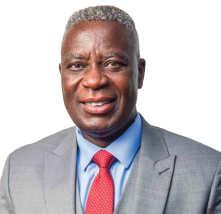
Speaking of the country’s investment drive in the energy sector, Ncube said that Zambia has become an attractive destination for investors because of the good governance and policy consistency of the current administration. This has translated into better independence for players in the energy sector that include ZESCO. The company’s corporate leadership team has developed a clear vision to restore its financial health and contribute to the development of the ESI. As a result, there has been an overwhelming subscription on potential IPPs, and ZESCO’s initiative to complete construction of the Kafue Gorge Power station using its own generated resources.
Halliburton Nigeria production facility reaches milestones
HALLIBURTON TESTING AND Subsea (TSS) Nigeria is celebrating two significant milestones: an early production facility (EPF) recently processed its 10 millionth barrel of oil, and reached this milestone with zero lost-time incident (LTI) days.
In 2019, a customer needed to fast track its oil production from two drilled wells and two planned wells. With support from the TSS Nigeria and global EPF team, TSS engaged with the customer and developed a practical solution to meet the requirement.
Halliburton built, operated, and maintained an EPF in a remote and difficult-to-engineer area in the Niger Delta. The facility, which is capable of handling 22,000 bbls of oil per day with up to 7.5 MMscf of gas production and 5,000 bbls of water per day, opened after successful onsite location pre-commissioning checks.
“In the past three years of EPF production, we have achieved a 10million-barrel milestone while maintaining over 97% uptime,” said Iyen Idienumah, Testing and Subsea country manager for Nigeria. “This is a testament to the dedication and tireless efforts of the TSS EPF team.”
ADVERTISE R’S INDEX Container World Pty Ltd............................................................................................................19 Eko Hotel and Suites..................................................................................................................35 Oman Cement Company............................................................................................................36
01 02 03 04 05 54 03 02 01
64 04 06 16 08 10 74
POWER GENERATION ISSUE 2 2023 • WWW.OI LREVIEWAFRICA.COM 33 Image Credit: Image Credit: ZESCO
Vickson Ncube is the board chairman of ZESCO.
NETWORKING A VAST SYSTEM
Seamless telecommunications can often influence factors like CAPEX and OPEX.

THE ISSUE OF security and communications in oil and gas ultimately comes down to the concept of resilience. The industry has to often weather adverse situations that calls for round-the-clock monitoring and intense testing to avoid possible failures throughout the complicated process. The sector requires security and communications assistance across multiple applications, such as delivering sub-sea data back to shore and remote monitoring and management of nuclear sites to support both operations and emergency preparedness.
Companies providing security and communications services take into account how to build a strong network out of the complicated processes of the industry. They are expected to provide adverse oil and gas environments with high speed and bandwidth that developed areas enjoy. This is important as factors like captial expenditure (CAPEX) and operational expenditure (OPEX) are driven to certain extent by seamless telecommunications.
Inmarsat’s ELERA IoT is one company that offers end-to-end transperancy from extraction to distribution, even in the most unaccessible locations. From connecting huge numbers of gas wells to covering vast kilometres of pipelines, the company
provides seamless automation, thus eliminating all kinds of risks involved in the process.
On the wellhead monitoring front, ELERA products can help reduce unplanned downtime, time and cost of monitoring, and
resulting fines from the environmental impact.
Another company, Commend, provides services to a wide range of aspects in the oil and gas industry from refineries, petrochemical plants, drilling rigs and production platforms to liquiefied natural gas (LNG), ammonia, urea plants and terminals, FLNG, FPSO, FPDSO, FSRU and oil tankers, pipelines, hydraulic fracturing and oil sands, to name a few.
Their systems are designed while keeping in mind their
speech intelligibility even under the most weathered scenarios. From basic physical sound properties to signal processing, the company takes into consideration every small detail, when it comes to perfecting acoustic qualities.
Recently, Aramco has signed a non-binding memorandum of understanding (MoU) with Samsung Electronics, which sets forth preliminary plans for a strategic collaboration that would localise an industrial 5G technology ecosystem in Saudi Arabia.
Speech intelligebility is an integral part of security and communications.”
SECURITY AND COMMUNICATIONS ISSUE 2 2023 • WWW.OI LREVIEWAFRICA.COM 34
Harsh oil and gas environments require high speed and bandwidth for efficient operation.
Image Credit: Adobe Stock

